PROXY MONITOR
REPORT
Fall 2012
A Report on Corporate Governance and Shareholder Activism
By James R. Copland
With Yevgeniy Feyman and Margaret O’Keefe
DOWNLOAD PDF
EXECUTIVE SUMMARY
In recent years, activist shareholders have pushed publicly traded American corporations to reform their practices. In 2012, labor unions and associated organizers under the “Occupy” umbrella have been especially active in challenging executives’ pay. These activists, along with “socially responsible” investing funds allied with certain academics, nonprofit groups, and Democratic Party activists, have also challenged corporations’ political spending—an issue brought to the forefront of public discourse by a presidential election campaign.
Such efforts have largely dominated the corporate proxy season, in which shareholders vote on corporate business at companies’ annual meetings.
This report draws upon information in the Proxy Monitor database to assess the 2012 proxy season in historical context. Among its key findings:
- A small group of shareholders continue to sponsor the overwhelming majority of shareholder proposals. In 2012, 36 percent of all such proposals were sponsored by labor-union pension funds; 31 percent were sponsored by three individual investors and their relatives and family trusts; and 22 percent were sponsored by investors with a “socially responsible” investing purpose or express religious or public policy purpose. Only 10 percent of shareholder proposals were sponsored by individuals other than the three “corporate gadflies,” and only 1 percent by institutional investors unaffiliated with organized labor or a social, religious, or public policy purpose.
- Public-employee pension funds played a heightened role in the 2012 proxy season, sponsoring 38 percent of all labor-backed proposals, as compared with 26 percent in the entire 2006–12 period.
- Religious-affiliated investors were far less active in the 2012 proxy season: proposals backed by religious investors constituted only 15 percent of all proposals backed by social, religious, or policy groups, as compared with 42 percent in the full 2006–12 period. Notably, Catholic orders of nuns sponsored only two proposals at Fortune 200 companies in 2012, as compared with 11 in 2011 and 16 to 19 annually between 2006 and 2012.
- Shareholder proposals related to corporations’ political spending grew in number in 2012 but gained little traction. Proposals seeking to increase the disclosure of or to limit companies’ lobbying or spending on political purposes constituted a plurality of all proposals in 2012 and 45 percent of proposals with a social or policy-related purpose. The number of such proposals submitted per company in the Fortune 200 was 20 percent higher than in 2011, double that in 2010, and more than three times that in 2008. However, only 17 percent of shareholders, on average, supported these proposals in 2012, down from 22 percent in 2011 and lower than any other year in the 2006–12 period.
- Labor-union pension funds’ sponsorship of shareholder proposals appears to be unrelated to shareholder return and connected to union-organizing activities and other labor objectives. As is the case across the full 2006–12 period, labor pension funds’ shareholder proposals are concentrated in companies and industrial sectors targeted by union-organizing campaigns. Each of the companies facing more than two labor-sponsored shareholder proposals in 2012 had share returns that outperformed its peer group in 2011; each company, however, had been engaged in public disputes with labor unions or had played an active role in the political process against organized labor’s interests.
- The number of shareholder proposals receiving majority support fell in 2012, but this shift appears to be attributable to the types of proposals being introduced rather than a broader trend. Only 6 percent of shareholder proposals received majority backing at Fortune 200 companies in 2012, down from 7 percent in 2011, and below every other year in the full 2006–12 period. The average shareholder vote in 2012, however, was 25 percent, in line with the 2006–12 average. Econometric analysis of Proxy Monitor data shows that there is no statistically significant difference between 2012 shareholder voting and other years; the decrease in voting this year instead appears to be attributable mostly to shifts in the composition of shareholder proposals.
- The recommendations of the proxy advisory firm ISS significantly influence shareholder voting, though the firm’s recommendations are systematically more inclined to favor such proposals than are the majority of shareholders. The proxy advisory firm Institutional Shareholder Services (ISS) makes recommendations to institutional investors on shareholder voting and has a dominant market share position (61 percent). Econometric analysis of Proxy Monitor data shows that a positive recommendation from ISS increases voting support for a shareholder proposal by 15 percent, controlling for other factors. However, ISS consistently supports a much higher share of shareholder proposals (63 percent) than do shareholders overall (less than 8 percent).
Overall, empirical analysis of Proxy Monitor data, in 2012 and across the 2006–12 time span, challenges the efficacy of the shareholder-proposal process, at least from the perspective of the ordinary investor. The prominent role being played by a small number of investors, most prominently labor-union pension funds whose actions in this area appear to deviate from concern over share value, suggests that this process may be oriented toward influencing corporate behavior in a manner that generates private returns to a subset of investors while harming the average diversified investor. The significant influence of the proxy advisory firm ISS, along with its substantial deviation from shareholders’ observed preferences, amplifies concerns about whether shareholder voting on proxy ballot items is effectively working to improve share value.
INTRODUCTION
With a presidential campaign in full swing, the “Occupy” movement in the news, and much talk of economic ills in the air, “shareholder activism” once again marked the 2012 season of American corporations’ annual meetings—when shareholders vote on the companies’ business, in person or by proxy.[1] At the meetings, labor unions and associated organizers under the “Occupy” umbrella were especially active in challenging executives’ pay.[2] In an election year with much talk about “money in politics,” these and certain other activist investors have also used annual meetings to attempt to rein in corporations’ political participation.[3]
Most of the time, these pay challenges have been launched through shareholder-advisory votes on executive compensation. These are now mandated under the Dodd-Frank Wall Street Reform and Consumer Protection Act of 2010.[4] Challenges to corporations’ political spending, on the other hand, have come in the form of shareholder proposals introduced on corporate proxy statements; such proposals can come from any shareholder who has owned at least $2,000 of stock for at least one year.[5] Politics-related proposals were significant in 2012: for the first time, they represented a plurality of shareholder-activist statements. Indeed, one of the major news stories of this year’s proxy season is the aggressive effort by labor-union pension funds, with “social investing” funds, to rein in corporate political participation.
A long-standing norm in the American securities industry holds that maximizing share price is the sole fiduciary duty of corporate managers, but some corporate-law scholars have argued that the duty of management ought to extend beyond shareholders and share value to the interests of a broader class of “stakeholders.”[6] Social investing funds, of course, exist to address social and political issues beyond share value. However, labor-union pension funds are not as free to define and pursue other interests. In fact, they are forbidden to look beyond share value, under the federal Employee Retirement Income Security Act (ERISA).[7] In other words, while there is ongoing debate about whether managers have a duty to look beyond share price, there is no ambiguity about a retirement fund’s fiduciary duties. The law requires such funds to protect retirees’ investment interests. Consequently, even as social investing funds and labor-affiliated pension funds engage in similar forms of shareholder activism, labor-affiliated funds have faced more scrutiny about the appropriateness of their decisions.[8] In 2012, however, these considerations did not seem to rein in their shareholder activism.
This report examines trends in shareholder-proposal activism in 2012 and places these trends in historical context. The data set for this report includes all shareholder proposals submitted to the Fortune 200 companies dating back to 2006, drawn from companies’ public filings with the Securities and Exchange Commission (SEC) and collated in the Manhattan Institute’s publicly available database, ProxyMonitor.org. Data for 2012 are current to July 15, at which time 178 of the Fortune 200 companies had filed proxy documents with the SEC and 173 had held their annual meetings.
Part I of this report outlines the broad contours of shareholder-proposal activism this season, by describing the major sponsor of shareholder proposals and the main topics of these proposals. Part I thus addresses these questions:
- Who is driving shareholder activism—who are the most frequent sponsors of shareholder proposals?
- What is the subject of shareholder activism—what are the principal agendas being advanced through shareholder proposals?
Part II of the report delves more deeply into the shareholder-proposal process by looking at the characteristics of targeted companies and industries and at the voting results for different classes of proposals. Part II therefore addresses these questions:
- Where is shareholder activism focused—which companies and industries are being targeted with shareholder proposals?
- How have shareholder proposals fared—which shareholder proposals have been likely to succeed or gain traction?
BACKGROUND: ABOUT PROXY MONITOR
Legal scholars disagree about the appropriate role to be played by shareholders in corporate governance. One school, led most prominently by Harvard’s Lucian Bebchuk, has praised expansions of the shareholder-proposal process, arguing that shareholders have inadequate rights vis-à-vis the corporation and that equity owners lack the means to enforce their interests against corporate management’s.[9] Other leading academics, such as UCLA’s Stephen Bainbridge, have argued that shareholders’ interests are adequately protected by their ability to sell their shares and sue for breaches of fiduciary duty. These scholars worry that expanding shareholder power could lead to politicized outcomes, which would hurt share value by interfering with business judgment that is better delegated to professional managers, overseen by boards of directors.[10]
Responding to the need for empirical evidence in this debate, the Manhattan Institute’s Center for Legal Policy debuted a new online database, ProxyMonitor.org, in 2011. The database is the first publicly available resource containing easily searchable and sortable information on public-company shareholder proposals. The database initially cataloged proposals dating back to 2008 for the 100 largest American companies by revenues, according to Fortune magazine. It has subsequently been expanded to include the 200 largest companies, with proposals dating back to 2006 and, of course, now updated to include activity from the 2012 meeting season.
Beginning in 2011, James Copland, director of the Center for Legal Policy, has issued an annual assessment of the proxy season as a whole.[11]This report is the second in that series. It follows Copland’s series of “findings” about the most critical issues arising during the proxy season, which were published earlier this year.[12]
|
BACKGROUND: WHAT DO WE MEAN BY "SHAREHOLDER ACTIVISM"?
Shareholder activism is the effort by owners of equity capital to use their shares’ voting power to change the behavior of corporate management. The focus of this report—and the Proxy Monitor project generally—is the exercise of such power through shareholder proposals, which any owner of shares valued at $2,000 or more, and held for one year, can introduce at the annual meeting of a publicly held corporation.[13]
Shareholder activism for social and political causes must be distinguished from pressure put on corporate management by holders of large stakes, whose goal is a better return on their investment. This practice first captured public attention in the 1980s, when active investors began pressuring companies aggressively to improve share value, and a wave of takeovers restructured corporate America. (The phenomenon soon entered popular culture in books and movies like Barbarians at the Gate.)[14] Such efforts have gained renewed attention in the current news cycle, through the scrutiny of presidential candidate Mitt Romney’s record as a private-equity specialist.[15] Generally speaking, this form of active investing has a strong record of increasing share value, to the benefit of all shareholders.[16]
Though the focus of this report is social and political activism, it is worth noting that share-value-centered activism—by big investors who have large share holdings in the companies whose managements they target directly—also has been common in 2012.[17] Interestingly, there is at least some interaction effect between these efforts and recent shareholder-proposal activism. In recent years, a wave of shareholder-activist proposals on corporate governance were adopted, requiring directors to win a majority of votes for election and eliminating “staggered boards” that prevented activists from challenging an entire slate of directors in a single year. The effect of these changes has been to enable value-oriented investors to threaten boards and management without having to prepare for a full-scale proxy fight for board control. Since the beginning of the 2010 proxy season, this threat has been heightened by the decision of the New York Stock Exchange, approved by the Securities and Exchange Commission (SEC), to prevent brokers from voting their beneficial owners’ shares for directors in uncontested elections.[18]
|
To shed further light on the second question, Part II of the report introduces a statistical model testing various factors that could explain voting results of shareholder proposals, including the recommendations of the leading proxy advisory firm, Institutional Shareholder Services (ISS).[19]
 OVERVIEW: SHAREHOLDER PROPOSALS IN 2012 AND HISTORICAL PERSPECTIVE
OVERVIEW: SHAREHOLDER PROPOSALS IN 2012 AND HISTORICAL PERSPECTIVE
Shareholder proposals at annual meetings were fewer in 2012 than they were earlier in the decade (though 2012’s activism shows an increase from 2011’s). As of July 15, shareholders had introduced 1.43 proposals per company in the Fortune 200, up slightly from 1.34 proposals introduced in 2011. (Almost all such proposals introduced at annual meetings are from a small group of shareholder activists.) The number of proposals introduced in both 2011 and 2012 is lower than that witnessed in 2006 through 2010, when the number of proposals introduced per company ranged from 1.59 to 1.75.
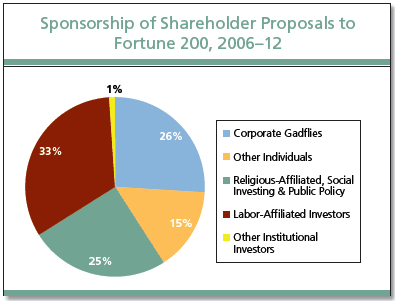 The decline in the overall number of proposals is most likely attributable to two factors. First, one subject of past shareholder resolutions has been addressed by federal law: Dodd-Frank[20] required that, beginning in 2011, all publicly held companies hold regular shareholder-advisory votes on executive compensation. Calls for such votes were among the most regularly introduced proposals at companies through 2010.
The decline in the overall number of proposals is most likely attributable to two factors. First, one subject of past shareholder resolutions has been addressed by federal law: Dodd-Frank[20] required that, beginning in 2011, all publicly held companies hold regular shareholder-advisory votes on executive compensation. Calls for such votes were among the most regularly introduced proposals at companies through 2010.
Second, proposals to “declassify” corporate boards to make them more accountable—for example, to end staggered terms for directors and subject every director position to election every year, or to require each director to receive a majority of votes cast to be elected—have been relatively popular with shareholders and frequently approved in recent years. Such resolutions are less frequently introduced because, in many Fortune 200 companies, they have been adopted.
PART I. MAJOR SHAREHOLDER-PROPOSAL SPONSORS AND TOPICS
(a) Who is driving shareholder activism?
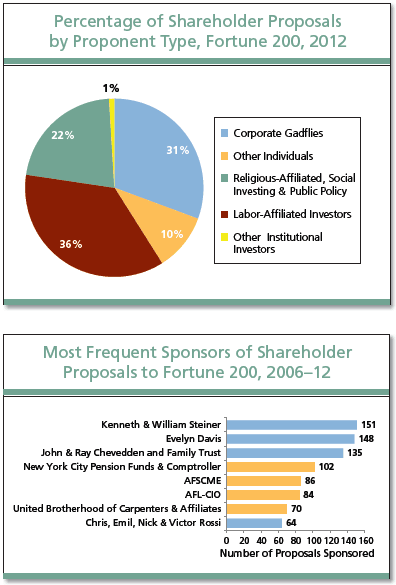 The creation of the Proxy Monitor database last year soon revealed that a relatively small subset of investors drives the shareholder-proposal process. This trend, quite clear in 2011, has not changed. From 2006 through 2012, 84 percent of shareholder proposals have been sponsored by one of three investor types:
The creation of the Proxy Monitor database last year soon revealed that a relatively small subset of investors drives the shareholder-proposal process. This trend, quite clear in 2011, has not changed. From 2006 through 2012, 84 percent of shareholder proposals have been sponsored by one of three investor types:
1) Four individual “corporate gadflies” and their family members;[21]
2) Pension funds and other investment vehicles affiliated with labor unions, in both the public and private sectors; and
3) Investment vehicles affiliated with religious organizations or public policy groups, or otherwise organized as “social investment” funds, with express interests beyond mere share-price maximization.
An additional 15 percent of shareholder proposals are submitted by other individual investors, though many of these individuals are themselves “repeat filers,” also best characterized as gadflies, such as Gerald Armstrong.[22] Others are social investors, such as John Harrington,[23] who submits proposals in his own name in addition to those sponsored through his social investment fund, Harrington Investments. Only 1 percent of proposals have been filed by large institutional investors that do not have an express social policy orientation—hedge funds, mutual funds, and the like. This suggests that most institutional investors could be largely indifferent to the shareholder-proposal process, or that they view the process as an ineffective tool in driving shareholder returns.
Organized labor’s investment funds have long played a large role in shareholder activism. In fact, these funds introduced a plurality of all shareholder proposals from 2006 through 2012: fully one-third of all proposals have been submitted by them. In 2012, the percentage of proposals sponsored by labor-affiliated investors was even higher: 36 percent. The share of proposals introduced by the main four corporate gadflies also rose—to 31 percent, from 26 percent in 2011. Meanwhile, the share of proposals backed by all other individuals declined from 15 percent to 10 percent. The percentage of proposals introduced by investment funds with a religious, policy, or social orientation also declined slightly in 2012, from 25 percent to 22 percent.
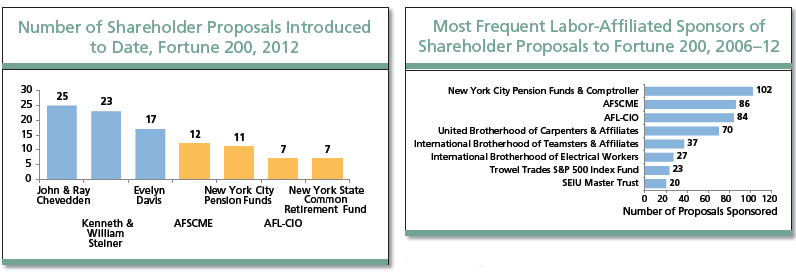
1) The Four Corporate Gadflies
Well-known corporate gadflies—Evelyn Davis (see “Special Focus”), John Chevedden, and William Steiner and members of their families—have been far and away the most regular individual sponsors of shareholder proposals at Fortune 200 companies from 2006 through 2012, collectively sponsoring 434 proposals over that period. Members of the Rossi family introduced 64 shareholder proposals to Fortune 200 companies over the period. In 2012, Chevedden, Steiner, and Davis were again the most frequent sponsors of shareholder proposals to Fortune 200 companies (notwithstanding Davis’s declaration that she would “scale back” her activism this year).
2) Labor-affiliated investors
After the corporate gadflies, the most frequent sponsors of shareholder proposals in 2012 were all affiliated with organized labor, including, most prominently, the pension funds for New York City’s employees and the office of that city’s comptroller, who manages these funds. The other regular sponsors of shareholder proposals affiliated with organized labor have been the pension funds of the American Federation of State, County, and Municipal Employees (AFSCME); the American Federation of Labor–Congress of Industrial Organizations (AFL-CIO); and the United Brotherhood of Carpenters and its affiliates.

AFSCME, the New York City funds, and the AFL-CIO were again active this year, along with the New York State pension funds, which began introducing shareholder proposals only in 2010 but have since become significant shareholder-proposal activists. Most notably, 2012 witnessed a large increase in the share of labor-affiliated proposals introduced by public-employee pension funds, relative to private labor-union funds. Whereas private labor funds sponsored 54 percent of all shareholder proposals over the entire 2006–12 period, they only backed 41 percent of labor-affiliated proposals this year, while the share of proposals sponsored by state and city public-employee pension funds rose from 26 percent to 38 percent.
SPECIAL FOCUS: CORPORATE GADFLIES
Evelyn Davis
Davis, 82, is a four-time divorcée[24] who has become a millionaire investing money given to her by her father and acquired in her divorce settlements.[25] Davis also publishes a yearly investor newsletter, Highlights and Lowlights, which earns her an estimated $600,000 annual income.[26] According to one media account, Davis sells the $495, 20-page newsletter in part by “cajol[ing] the nation’s business titans into subscribing … with a minimum order of two copies.”[27] Company executives also regularly shower largesse on Davis to stay in her good graces. According to one report in the 1990s, executives of all three major American car companies offered to deliver any car she purchased to her. Lee Iacocca reportedly said that he would do so in person.[28]
Davis is known for her eccentricity. At an annual meeting early in her career, she stripped down to a bathing suit.[29] She once nominated to the board of ITT one Koo Stark, a soft-porn actress who was romantically linked to Britain’s Prince Andrew, asserting that the company “needed influence with the British royal family.”[30]
Calling herself “a gadfly with a fortune,” Davis says that she is motivated not by wealth but by power: “The power—that’s really what life is all about. It’s all how you use it. It’s better than being a nonentity. I couldn’t stand being a nonentity.”[31] Notwithstanding her activity and prominence, Davis has rarely been successful in her shareholder-proposal efforts: only one of her 148 proposals submitted to the Fortune 200 has been approved by a majority of shareholders. It was a 2006 Bank of New York Mellon proposal calling for cumulative voting—the ability to aggregate one’s ballots for multiple director positions behind a single or smaller number of preferred candidates.
John Chevedden and Allies
Unlike the eccentric Davis, John Chevedden and his allies in the Steiner and Rossi families have gained significant traction: 102 of the 350 proposals introduced by these three activists, their family members, and trusts have received majority shareholder support. Unlike Davis, who regularly makes a spectacle at annual meetings, Chevedden and his allies rarely speak at such events, instead focusing on their written filings.[32]
Chevedden, 66, of Southern California, began attending shareholder meetings in the 1960s.[33] He was an early exponent of “say on pay”—shareholder-advisory votes on executive compensation, now mandated for all U.S. public companies under Dodd-Frank—before the idea was embraced by labor pension funds.[34] He has since launched efforts aimed at encouraging companies to permit shareholder action outside the annual meeting process, either by calling special meetings or through written consent. (Power to act by written consent is common in smaller, privately held companies but, until recently, was not on the corporate governance agenda for large, publicly traded corporations.)
William Steiner began proposing shareholder resolutions in the 1980s, and his son, Ken, has been dubbed Chevedden’s “East Coast counterpart,” though the two have never met in person.[35] Emil Rossi began attending shareholder meetings in the 1960s; having never attended college, he was reportedly motivated initially by his displeasure in observing that boards of directors tended to be populated by graduates of famous colleges such as Harvard.[36] Rossi’s efforts have been reportedly aided by Chevedden in more recent years,[37] and, like Steiner, Rossi has now substantially passed along his gadfly efforts to his progeny—notably, sons Chris and Nick.[38]
SEC rules permit the submission of one resolution per shareholder at each annual meeting. Some have suggested that Chevedden finds “ ‘alter egos’ who own shares in companies that he does not” himself own in order “to skirt” these requirements, as well as to “have a voice at meetings where he is not eligible.”[39]
Whereas companies have tended to respond to Davis with kindness, many have taken more hostile attitudes toward Chevedden. Both KBR and Apache successfully sued to exclude proposals introduced by Chevedden from their ballots, after he was unable to prove that he was actually one of the company’s shareholders.[40] Limited Brands also sued Chevedden, alleging that his proxy proposals included “ ‘objectively false statements that are materially misleading’ under U.S. securities laws.”[41]
|
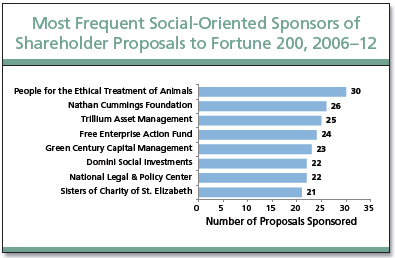 3) Social-oriented investors
3) Social-oriented investors
Though they are less active than the corporate gadflies and labor-affiliated funds, religious, public policy, and social investors in the aggregate do play a major role in the shareholder-proposal process. Eight such social investors sponsored 20 or more proposals at Fortune 200 companies in the 2006–12 period. They included policy groups such as the People for the Ethical Treatment of Animals and the National Legal and Policy Center; charitable foundations with a social orientation, such as the Nathan Cummings Foundation;[42] religious organizations, such as the Sisters of Charity of St. Elizabeth and similar Catholic orders, usually consisting of nuns; and social investing funds, such as Trillium Asset Management, the Free Enterprise Action Fund, Green Century Capital Management, and Domini Social Investments.
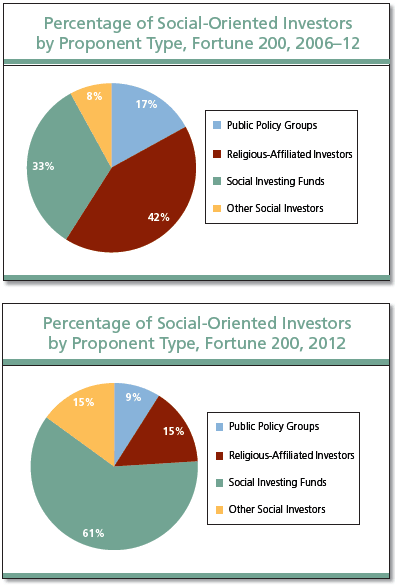 In 2012, social investing funds were more active than in earlier years, while religious organizations were less so. Social investing funds introduced 61 percent of activist proposals in 2012, while their overall average for the entire 2006–12 period is only 33 percent. Conversely, the share of proposals backed by religious investors fell from 42 percent across the full period to just 15 percent in 2012.
In 2012, social investing funds were more active than in earlier years, while religious organizations were less so. Social investing funds introduced 61 percent of activist proposals in 2012, while their overall average for the entire 2006–12 period is only 33 percent. Conversely, the share of proposals backed by religious investors fell from 42 percent across the full period to just 15 percent in 2012.
Social investing funds’ increased role may be explained in part by the increased focus this proxy season on corporate political participation—an issue of keen interest to these funds, as it is to organized labor. Helping to explain the decline in shareholder-proposal activity by religious groups this year is the conspicuous absence of proposals backed by Catholic orders of nuns. This group of investors introduced 16 to 19 proposals each year at Fortune 200 companies from 2006 through 2010, and 11 proposals last year; in 2012, though, they have only introduced two proposals so far. It is possible that this retreat is due to the Vatican’s recent, well-publicized reprimand of U.S. nuns for their perceived political radicalism.[43]
(b) What is the subject of shareholder activism?
The Manhattan Institute has grouped shareholder proposals in the ProxyMonitor.org data set into three major categories:
1) Executive compensation. These proposals seek to increase shareholder power over managerial pay packages, including equity compensation plans, “golden parachutes” (payouts granted to executives in the event of a change in corporate control), or “golden coffins” (insurance-type payouts given to executives’ estates in the event of untimely death).
2) Social policy. These proposals range from environmentalism to human rights, animal rights, and employment rights to corporate political activities. Like proposals concerning executive compensation, these proposals aim to change corporate actions directly. Unlike proposals involving executive compensation, though, these involve social or policy goals not related to the traditional concern of investors with protecting their interests vis-à-vis those of management. Both compensation and social policy proposals are substance-based: their goal is to focus on a particular corporate activity and change it.
3) Corporate governance. These proposals typically seek to modify the rules for electing directors or for voting on other business (to enable shareholders to act outside the annual meeting process) or to separate the positions of chairman and chief executive officer. Unlike executive compensation or social policy efforts, these proposals are process-based: they seek to change the allocation of power among boards, management, and shareholders, rather than aiming to change a specific corporate policy or practice.
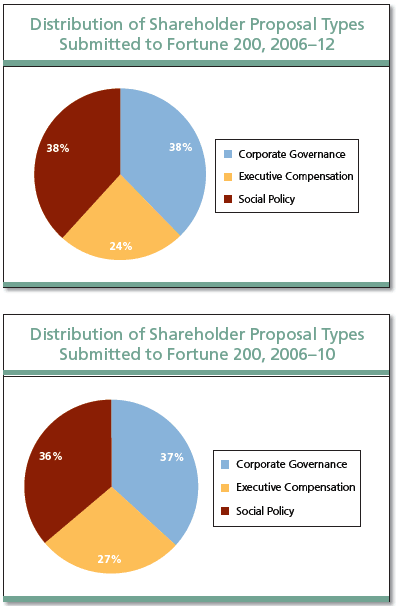
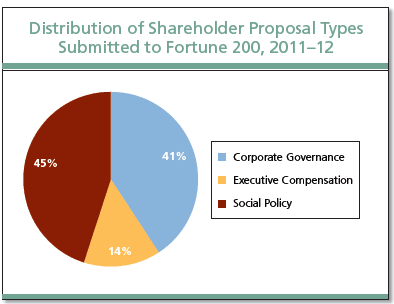 Between 2006 and 2012, 38 percent of shareholder proposals submitted to Fortune 200 companies have involved corporate governance, 38 percent have involved social policy, and 24 percent have involved executive compensation. As previously noted, the share of executive-compensation-related proposals has dropped off since 2010, when the Dodd-Frank law instituted mandatory shareholder votes on this topic. Executive compensation was the subject of 27 percent of all proposals introduced from 2006 through 2010, but of only 14 percent of all proposals over the last two years.
Between 2006 and 2012, 38 percent of shareholder proposals submitted to Fortune 200 companies have involved corporate governance, 38 percent have involved social policy, and 24 percent have involved executive compensation. As previously noted, the share of executive-compensation-related proposals has dropped off since 2010, when the Dodd-Frank law instituted mandatory shareholder votes on this topic. Executive compensation was the subject of 27 percent of all proposals introduced from 2006 through 2010, but of only 14 percent of all proposals over the last two years.
The last two years have also witnessed a slight increase in the number of social policy proposals relative to those involving corporate governance. The number of corporate-governance-related proposals may have shrunk because earlier proposals were adopted. The relative increase in social policy–related proposals is largely due to the increased number of proposals touching on corporate participation in the political process.
1) Executive Compensation
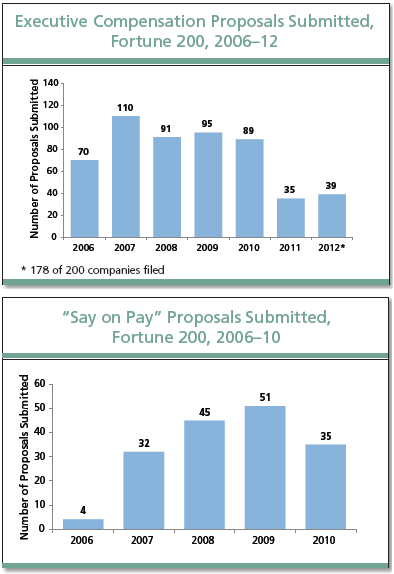 The history of shareholder proposals since 2006 shows increasing attention to executive compensation issues, then a leveling off in resolutions on this topic, and, most recently, the decline discussed above. The number of shareholder proposals related to executive compensation rose from 70 to 110 between 2006 and 2007, before steadying to a number between 89 and 95 from 2008 to 2010. These shifts are mostly explained by the growing prevalence of advisory votes on executive compensation in the second half of the past decade. Only four such proposals were on the ballots of Fortune 200 companies in 2006, when the “say-on-pay” effort began in earnest, but the number of such proposals rose to 32 in 2007 and continued to increase to a high of 51 in 2009, the year before Dodd-Frank was passed.
The history of shareholder proposals since 2006 shows increasing attention to executive compensation issues, then a leveling off in resolutions on this topic, and, most recently, the decline discussed above. The number of shareholder proposals related to executive compensation rose from 70 to 110 between 2006 and 2007, before steadying to a number between 89 and 95 from 2008 to 2010. These shifts are mostly explained by the growing prevalence of advisory votes on executive compensation in the second half of the past decade. Only four such proposals were on the ballots of Fortune 200 companies in 2006, when the “say-on-pay” effort began in earnest, but the number of such proposals rose to 32 in 2007 and continued to increase to a high of 51 in 2009, the year before Dodd-Frank was passed.
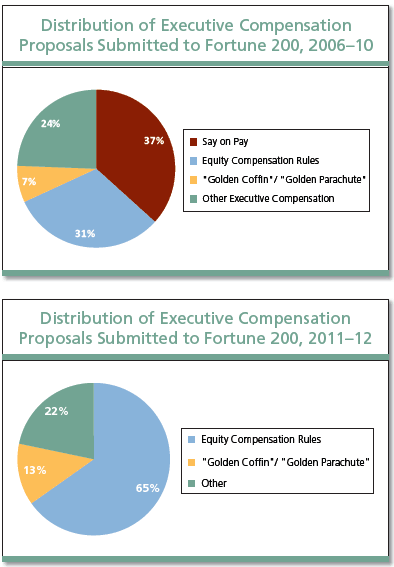 The increased attention to say-on-pay efforts, both before and after Dodd-Frank, seems to have crowded out earlier executive compensation ideas. The number of non-say-on-pay executive compensation proposals in 2012 was only 59 percent of the number introduced in 2006. The number of proposals relating to equity compensation plans and to golden parachutes or golden coffins remained relatively unchanged.
The increased attention to say-on-pay efforts, both before and after Dodd-Frank, seems to have crowded out earlier executive compensation ideas. The number of non-say-on-pay executive compensation proposals in 2012 was only 59 percent of the number introduced in 2006. The number of proposals relating to equity compensation plans and to golden parachutes or golden coffins remained relatively unchanged.
2) Social Policy
From 2006 through 2012, the most commonly introduced shareholder proposals at Fortune 200 companies involved environmental issues, such as greenhouse gas emissions, climate-change risk, and general concerns about “sustainability.” The second most common single type of proposal involved corporate political participation, including both spending and lobbying. Animal rights, employment rights, and other human rights were also regular topics of shareholder proposals, and several proposals during the run-up to the passage of the Patient Protection and Affordable Care Act of 2010[44] involved “health-care principles.”
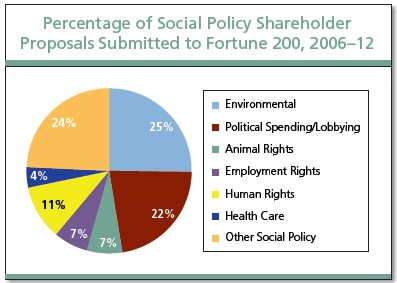 As we have mentioned, the election year 2012 was notable for a significant increase in the number of proposals related to corporate political spending and lobbying. Though such proposals constituted 22 percent of all social policy proposals introduced across the full 2006–12 period, they represented 45 percent of social policy resolutions this year. Fortune 200 companies have faced an average of 0.28 proposals related to political spending or lobbying in 2012, up from 0.20 proposals in 2011 and just 0.09 proposals as recently as 2008.
As we have mentioned, the election year 2012 was notable for a significant increase in the number of proposals related to corporate political spending and lobbying. Though such proposals constituted 22 percent of all social policy proposals introduced across the full 2006–12 period, they represented 45 percent of social policy resolutions this year. Fortune 200 companies have faced an average of 0.28 proposals related to political spending or lobbying in 2012, up from 0.20 proposals in 2011 and just 0.09 proposals as recently as 2008.
3) Corporate Governance
From 2006 through 2012, 37 percent of all corporate-governance-related proposals have involved shareholder voting rules. Most of these proposals have called for majority voting, either requiring directors to receive a majority of votes cast to be elected or permitting 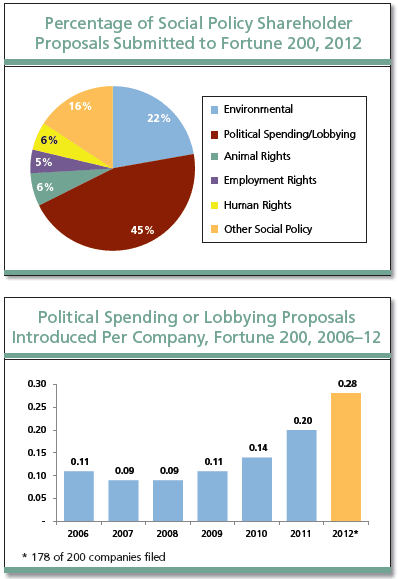 corporate bylaws to be amended by majority rather than supermajority vote. In addition, a significant share of “voting rules” proposals called upon companies to adopt cumulative voting for director elections; such proposals, which only received majority support once across the time period, have typically been sponsored by Evelyn Davis. Apart from voting rules, a significant fraction of corporate-governance proposals sought to establish an independent board chairmanship, separate from the chief executive officer. Others proposed permitting shareholders to take action outside the annual meeting process (either by calling special meetings or acting by written consent). Still others proposed “declassifying” a company’s board by requiring annual election of all directors.
corporate bylaws to be amended by majority rather than supermajority vote. In addition, a significant share of “voting rules” proposals called upon companies to adopt cumulative voting for director elections; such proposals, which only received majority support once across the time period, have typically been sponsored by Evelyn Davis. Apart from voting rules, a significant fraction of corporate-governance proposals sought to establish an independent board chairmanship, separate from the chief executive officer. Others proposed permitting shareholders to take action outside the annual meeting process (either by calling special meetings or acting by written consent). Still others proposed “declassifying” a company’s board by requiring annual election of all directors.
In 2012, proposals for chairman independence constituted a plurality of all governance-related proposals, following an announced campaign by labor-affiliated investors.[45] The number of chairman-independence proposals introduced per Fortune 200 company in 2012 was 0.17, more than double the number introduced in 2008 and the highest across the 2006–12 span.
Proposals seeking chairman independence have existed for years, despite a dearth of consistent empirical evidence that such policies increase share value.[46] In contrast, proposals seeking to enable shareholders to act outside the annual meeting process, by calling special meetings or acting through written consent, are relatively recent in origin. The incidence of special-meeting shareholder proposals at Fortune 200 companies rose 19-fold from 2006 to 2009, before subsequently declining. Written-consent proposals first appeared in 2010 but have since been relatively common; such proposals are the third most numerous single class of corporate-governance-related proposals in 2012.
PART II. SHAREHOLDER-PROPOSAL TARGETS AND VOTING RESULTS
(a) Where is shareholder activism focused?
Shareholder activists do not focus their efforts on all companies equally. One would expect, for instance, that companies that have experienced poor stock performance relative to their competitors might be more likely to draw activists’ scrutiny. Similarly, companies with larger market capitalizations—and consequently with more owners holding larger investments—would naturally tend to attract more resources in the shareholder-proposal process. Companies with large insider holdings may be less likely to receive shareholder proposals, given manager-owners’ ability to defeat them. And companies with a heavy concentration of institutional shareholders may be more likely to see an effect, on the basis of the expected relationship between institutional holdings and shareholder activism of this form.
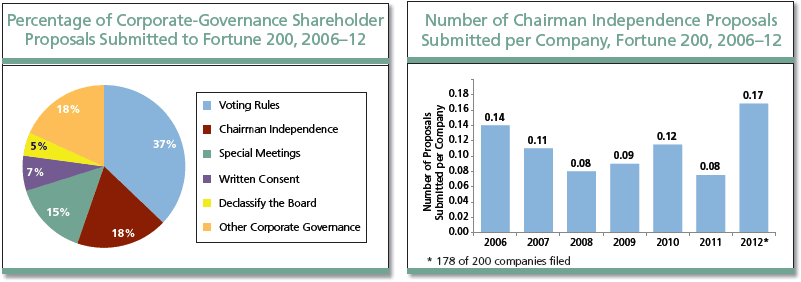
Moreover, at least some shareholder activists seek outcomes or benefits separate from those that would accrue to all shareholders through price appreciation, so it is natural to expect that factors other than return on investment should drive certain activists’ involvement, and that this should affect their choice of companies and industries. In addition, certain companies in certain sectors may be more sensitive to public-relations effects when facing proposals centered on social or political objectives. For instance, retail or consumer products companies, which might be vulnerable to consumer boycotts, are more likely to react to public-relations pressures than companies that sell mostly to business customers.
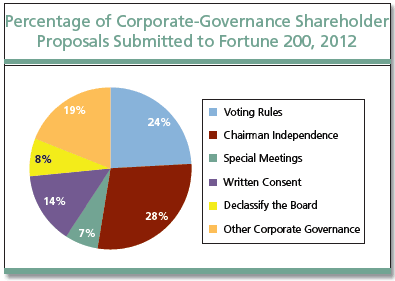 A full explanation of why certain companies are more likely to be targeted by shareholder proposals is beyond the scope of this study. However, some potential explanations suggest themselves, on the basis of the data in this report.
A full explanation of why certain companies are more likely to be targeted by shareholder proposals is beyond the scope of this study. However, some potential explanations suggest themselves, on the basis of the data in this report.
First, it is worth noting that larger companies are, as expected, more likely to attract higher numbers of shareholder proposals. The 39 Fortune 200 companies that received four or more shareholder proposals in 2012, for example, included nine of the ten largest companies by market capitalization: Apple, ExxonMobil, Microsoft, Wal-Mart, IBM, Chevron, AT&T, General Electric, and Johnson & Johnson. (The one outlier among America’s ten largest companies, Berkshire Hathaway, is substantially owned by chairman and chief executive Warren Buffett, so efforts to influence its behavior through shareholder proposals are unlikely to succeed.) Among the 18 Fortune 200 companies to receive five or more proposals in 2012, 14 were among the 50 largest American companies by stock-market capitalization, and two more (Boeing and Caterpillar) were among that group earlier in the year, though just outside it at the time of this writing. Almost all Fortune 200 companies that received five or more shareholder proposals were in the group of 50 largest companies by market capitalization. The only exceptions were two energy companies: Anadarko Petroleum and Dominion Resources.
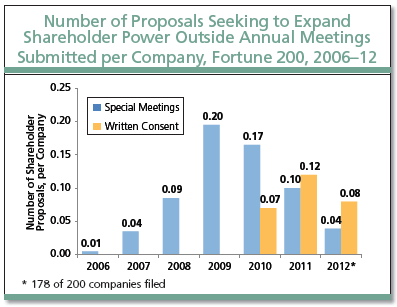 That both these companies were in the energy sector is significant. After sheer size, a company’s industry is a second key predictor of the number of shareholder proposals it attracts. The industries whose companies were most likely to attract shareholder proposals from 2006 through 2012 were financial services and energy. Companies in these sectors tend to be large, but they also share industry characteristics that attract shareholder activism. In finance, the key element is the 2008 market meltdown. Before 2009, the financial-services sector averaged 48 proposals annually, but over the last four years, it has averaged 66. The energy sector, meanwhile, is obviously placed to attract proposals related to environmental concerns.
That both these companies were in the energy sector is significant. After sheer size, a company’s industry is a second key predictor of the number of shareholder proposals it attracts. The industries whose companies were most likely to attract shareholder proposals from 2006 through 2012 were financial services and energy. Companies in these sectors tend to be large, but they also share industry characteristics that attract shareholder activism. In finance, the key element is the 2008 market meltdown. Before 2009, the financial-services sector averaged 48 proposals annually, but over the last four years, it has averaged 66. The energy sector, meanwhile, is obviously placed to attract proposals related to environmental concerns.
A third characteristic that attracts shareholder activism is the interest of organized labor. As mentioned above, labor-affiliated investors sponsor a plurality of all shareholder proposals, so their choices in targets help to explain industry-to-industry variation in shareholder-proposal activity. From 2006 through 2012, labor-affiliated investors disproportionately focused their proposals on companies in the retail, telecommunications, and financial-services sectors.
Earlier Proxy Monitor reports have explored the hypothesis that labor-union pension funds’ aggressive participation in the shareholder-proposal process “may be related more to organizing campaigns than to maximizing share returns,”[47] notwithstanding their obligation under ERISA to maximize share value in their pension management.[48] A June 2012 column by Harold Meyerson in the Washington Post makes just such a claim.[49] Moreover, within the last year and a half, both the Office of the Inspector General of the U.S. Department of Labor and the U.S. Court of Appeals for the D.C. Circuit have questioned the degree to which labor-union pension funds’ activities in the proxy process meet ERISA’s requirement that pension funds concentrate on share value.[50]
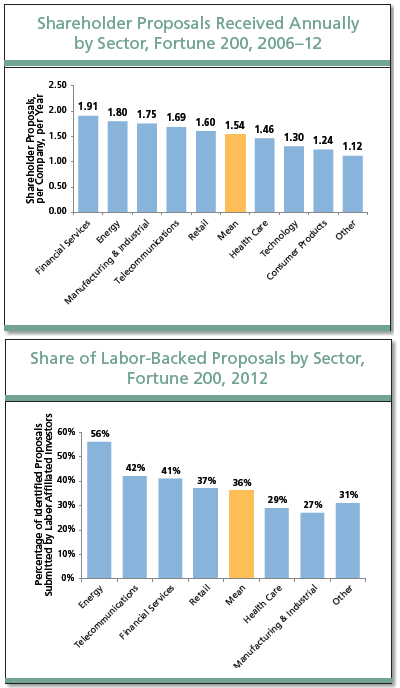 Given that the financial-services and retail sectors are both lightly unionized[51] and are significant public targets of union-organizing campaigns,[52] it is significant that these industries are more likely than others to be targeted for labor-backed shareholder proposals. Moreover, among the companies receiving multiple union-backed proposals in these sectors this year are publicly announced targets for unionization drives or the subjects of union contract-negotiation strikes: Bank of America, Citigroup, Rite Aid, Safeway, Wal-Mart, and Wells Fargo.[53]
Given that the financial-services and retail sectors are both lightly unionized[51] and are significant public targets of union-organizing campaigns,[52] it is significant that these industries are more likely than others to be targeted for labor-backed shareholder proposals. Moreover, among the companies receiving multiple union-backed proposals in these sectors this year are publicly announced targets for unionization drives or the subjects of union contract-negotiation strikes: Bank of America, Citigroup, Rite Aid, Safeway, Wal-Mart, and Wells Fargo.[53]
In 2012, companies in the telecommunications, financial-services, and retail sectors remained atypically likely to have received labor-backed shareholder proposals, as were energy firms. The share of energy-company proposals sponsored by labor-union funds is partly attributable to the previously discussed decrease in the share of 2012 shareholder proposals concerning the environment, which traces in significant part to reduced activities from Catholic orders of nuns and other religious-affiliated investors. Labor’s share increased because the other activists’ decreased.
Moreover, political reasons may explain labor’s particular focus on the only two energy companies that received multiple labor-backed proposals in 2012: Anadarko Petroleum (with four labor-backed proposals); and ExxonMobil (with three). That ExxonMobil received multiple labor-backed proposals is perhaps unsurprising, given the company’s size, but the company also notably gives disproportionately to Republican political candidates through its political action committee (88 percent of the $1.4 million donated by the ExxonMobil PAC in 2010 went to the GOP).[54] Similarly, Anadarko’s PAC contributed 79 percent of its $310,500 in 2010 political donations to Republicans,[55] and the company has made well-publicized efforts to develop the hydraulic fracturing of natural gas,[56] which is politically sensitive overall and particularly to unions with heavy dependence on coal-sector employment.[57] In any event, unions’ particular attention to these two companies does not seem to be a function of poor share-price performance: ExxonMobil’s 15.9 percent share-price appreciation in 2011 compares favorably with its peer group: Chevron (+16.6 percent), Royal Dutch Shell (+9.5 percent), ConocoPhillips (+7.0 percent), and BP (-3.2 percent). Similarly, Anadarko’s 0.2 percent 2011 share-price improvement compares well with similar companies: Chesapeake Energy (-14.0 percent), Halliburton (-15.5 percent), and Schlumberger (-18.2 percent).
In addition to ExxonMobil and Anadarko, only two other companies received more than two labor-backed proposals in 2012: Abbott Laboratories and Dean Foods. Again, each company seems to have been targeted for reasons other than share-price performance. Abbott received six labor-sponsored shareholder proposals in 2012, more than any other company, and these proposals were focused on management-sensitive topics: four addressed executive compensation, one chairman independence, and one lobbying disclosure. 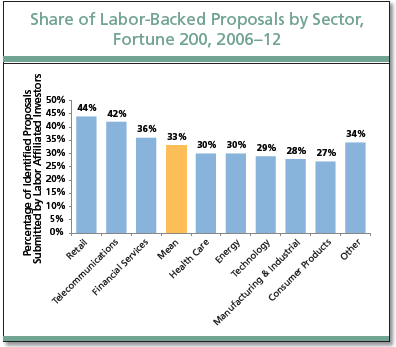 Significantly, Abbott CEO Miles White very publicly supported controversial changes to laws governing public-employee unions in Wisconsin, Illinois, and other states.[58] Then, too, the company has been the subject of recent legal disputes involving union pushes to grant overtime pay to pharmaceutical sales representatives.[59] Dairy giant Dean Foods, with three labor-backed proposals, has been targeted by the California Farmers Union for exerting market pressure on dairy farmers.[60] Again, it would be hard to attribute unions’ focus on these companies to poor share-price performance: in 2011, Abbott’s stock price appreciated 17.4 percent, compared with industry peers Pfizer (+23.6 percent), GlaxoSmithKline (+16.3 percent), Merck (+4.6 percent), and Novartis (-3.0 percent). And Dean’s price rose 26.7 percent, compared with foodstuffs peers Tyson Foods (+19.9 percent), Kraft Foods (+18.8 percent), Smithfield Foods (+17.7 percent), General Mills (+13.8 percent), and Kellogg (-1.0 percent).
Significantly, Abbott CEO Miles White very publicly supported controversial changes to laws governing public-employee unions in Wisconsin, Illinois, and other states.[58] Then, too, the company has been the subject of recent legal disputes involving union pushes to grant overtime pay to pharmaceutical sales representatives.[59] Dairy giant Dean Foods, with three labor-backed proposals, has been targeted by the California Farmers Union for exerting market pressure on dairy farmers.[60] Again, it would be hard to attribute unions’ focus on these companies to poor share-price performance: in 2011, Abbott’s stock price appreciated 17.4 percent, compared with industry peers Pfizer (+23.6 percent), GlaxoSmithKline (+16.3 percent), Merck (+4.6 percent), and Novartis (-3.0 percent). And Dean’s price rose 26.7 percent, compared with foodstuffs peers Tyson Foods (+19.9 percent), Kraft Foods (+18.8 percent), Smithfield Foods (+17.7 percent), General Mills (+13.8 percent), and Kellogg (-1.0 percent).
(b) How have shareholder proposals fared?
1) Overview of voting results
Overall vote totals for shareholder proposals have shown few major shifts across time, varying from 24 percent to 30 percent of votes cast across Fortune 200 companies from 2006 through 2012. The number and percentage of proposals receiving the backing of a majority of shareholders,[61] however, has varied markedly. In 2006, 53 shareholder proposals (15 percent of all introduced) won a majority (the highest rate in the Proxy Monitor database). In 2012, only 14 of these proposals (6 percent of all introduced) have received majority support. This is the lowest annual rate yet, and it reflects a general downward trend. There was some uptick in the number of proposals receiving majority support in 2009; but after the financial-market collapse, shareholder proposals have generally seen less likelihood of receiving majority support with the passing years.
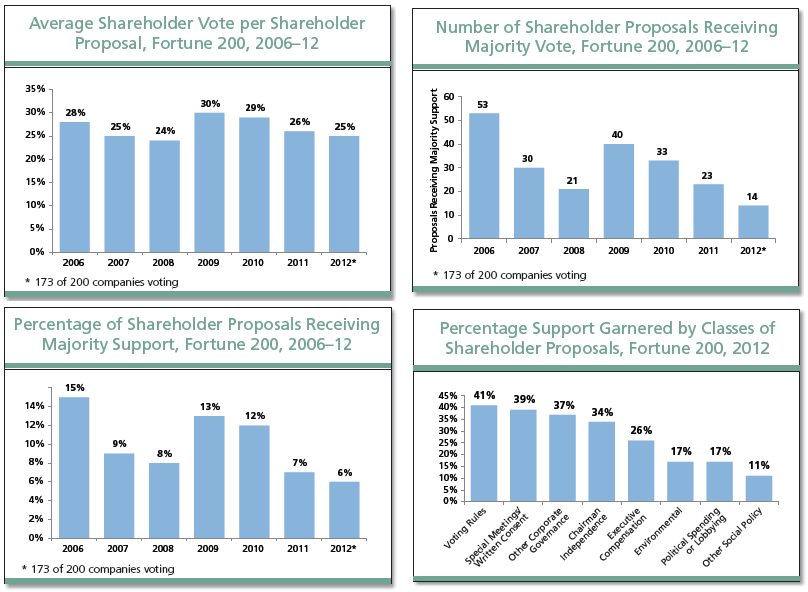
The key reason for this overall downward trend appears to be a shift from more popular proposals to less appealing ideas. In earlier years, a larger percentage of activist proposals were process-based—they sought to require directors to be elected by majority vote, or to declassify boards and force annual director elections, or to enable shareholders to act outside the annual meetings. These resolutions have been far more likely to be approved by a majority of shareholders than other classes of proposal. As these ideas have been adopted, though, they are less likely to be the subject of shareholder proposals, for the simple reason that they are no longer relevant for many companies. Hence, a greater proportion of recent proposals consists of substance-based suggestions for change that are less popular with shareholders because most shareholders generally believe that such substantive determinations fall more appropriately within the decision-making role of directors and management.
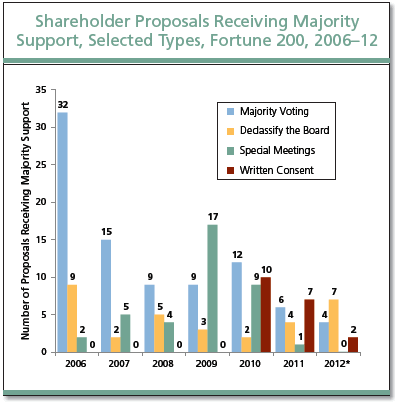 From 2006 to 2012, 165 proposals seeking to require directors to receive a majority of votes to be elected have been introduced at Fortune 200 companies, with 79 passing. Over time, as more and more companies have adopted majority voting, fewer of these proposals have been introduced. As we have discussed, proposals calling for shareholders to be able to call special meetings began to be introduced in larger numbers through 2009, before trailing off as more companies adopted such measures on their own. The new frontier in process proposals now seems to involve enabling shareholder action by written consent. These proposals were first introduced in 2010. (However, earlier resolutions’ history may not repeat itself: support for written-consent proposals seems to have waned in subsequent years.) Finally, 32 of 39 proposals to declassify boards introduced at Fortune 200 companies from 2006 through 2012 have received majority support from shareholders.
From 2006 to 2012, 165 proposals seeking to require directors to receive a majority of votes to be elected have been introduced at Fortune 200 companies, with 79 passing. Over time, as more and more companies have adopted majority voting, fewer of these proposals have been introduced. As we have discussed, proposals calling for shareholders to be able to call special meetings began to be introduced in larger numbers through 2009, before trailing off as more companies adopted such measures on their own. The new frontier in process proposals now seems to involve enabling shareholder action by written consent. These proposals were first introduced in 2010. (However, earlier resolutions’ history may not repeat itself: support for written-consent proposals seems to have waned in subsequent years.) Finally, 32 of 39 proposals to declassify boards introduced at Fortune 200 companies from 2006 through 2012 have received majority support from shareholders.
2) Statistical model of voting behavior
To test more fully the degree to which various factors influence shareholder voting results, Manhattan Institute researchers developed a statistical model. Omitting management-sponsored proposals in the Proxy Monitor database—solely consisting of 2011 and 2012 say-on-pay proposals and votes on the frequency of say-on-pay votes—the model attempts to explain the influence of company size, proposal type, proposal sponsor, and the recommendations of the proxy advisory firm ISS (see box below) on shareholder voting at Fortune 200 companies, from 2006 through 2012. Our results are summarized below and discussed in more detail in a technical appendix.
In summary, our statistical analysis finds a strong, positive relationship between ISS’s recommendations and shareholder voting behavior: on average, controlling for other factors, an ISS recommendation in favor of a shareholder proposal increased its favorable shareholder vote by 15 percentage points. Proposals backed by labor-affiliated pension funds received slightly more support than those backed by individuals, by 4 percentage points on average. The type of proposal in general had a significant effect on shareholder voting support. Finally, shareholder proposals on average received lower favorable votes at larger companies, measured by revenues.
SPECIAL FOCUS: PROPOSALS ON CORPORATE POLITICAL SPENDING OR LOBBYING
Proposals centering on companies’ political spending or lobbying have not gained significant traction with shareholders: only one such proposal introduced at a Fortune 200 company from 2006 through 2012 has received the support of a majority of shareholders. This was a 2006 proposal asking Amgen to prepare a report on its political contributions policy, which was supported by 67 percent of shareholders after the company’s board of directors endorsed the proposal. Apart from that resolution, only one political-spending-related shareholder proposal submitted to a Fortune 200 company received the support of as many as 40 percent of shareholders. It was a disclosure proposal at Sprint that received 41 percent of the vote in 2011. (Notably, shareholder support for an essentially identical proposal at Sprint fell to 19 percent in 2012—highlighting the importance of corporate response to such proposals and communications with institutional investors.) Nevertheless, given the aforementioned increase in the filing of political-activity proposals—with political-spending-related proposals constituting a plurality of shareholder proposals in 2012—and given the significant media attention paid to such proposals,[62] the subject warrants careful attention.
Overall, in 2012, Fortune 200 shareholder proposals relating to political spending or lobbying received only 17 percent support. This is the lowest level of any year in the Proxy Monitor database. This decrease is partly attributable to an increase in “outlier” resolutions, such as those that seek shareholder-advisory votes on political spending (backed by the social investing fund Northstar Asset Management) and proposals seeking to prohibit all corporate political spending (backed by the social investing funds Green Century Capital Management and Trillium Asset Management). These proposals received low-single-digit shareholder support. That said, shareholder votes across all classes of political-spending proposals generally declined, including among the more limited class of political-spending-disclosure proposals advocated by the Center for Political Accountability,[63] for which shareholder support across the Fortune 200 fell from 26.6 percent in 2011 to 22.7 percent in 2012.[64]
One likely reason that shareholder proposals about corporations’ political spending have failed is that such spending is generally important to share value. Institutional investors without a social investing orientation have a fiduciary duty to vote in a way that will maximize the price of their shares. Though three recent academic studies (much cited by advocates of limits on corporate political engagement) have argued that corporate political participation generally harms share value,[65] a vast 20-year academic literature generally finds political engagement to benefit corporate returns.[66] A separate question, not addressed in that scholarship, is whether greater disclosure of corporate political activities affects share value. However, it is clear that at least some advocates press for disclosure in order to discourage corporate political engagement.[67] This is obvious, for example, in the fact that the social investing fund Trillium Asset Management backed various proposals in 2011 and 2012 that sought not only to increase disclosure of political spending or lobbying policies and practices but also to prohibit corporate political participation altogether.
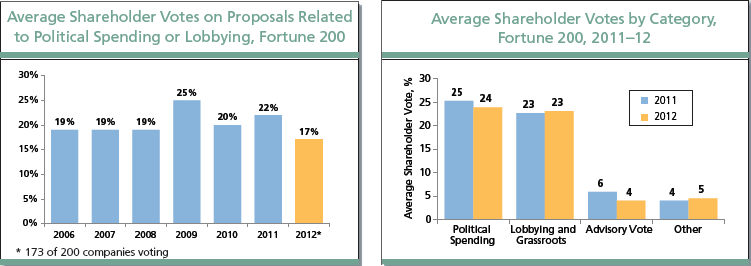
|
To reach these conclusions, we constructed an econometric model using a standard Ordinary Least Squares (OLS) regression. The main statistical specification used to reach such conclusions was:
Voting % = β0 + Company Size + Proposal Type +
Proponent Type + Year + ISS Recommendation + ε Eq. A
The dependent variable of interest, Voting %, measures the percentage vote for each shareholder proposal. β0 and ε are standard regression terms, respectively signifying the “intercept” (here, in essence, the average vote total at a company for baseline measures of other variables) and “error” term (the residual standard errors in the model). Company Size is a logarithmic measure of company revenues in the year corresponding to the proposal. (Our rationale for using a logarithmic variable is explained in the technical appendix.) Proposal Type is a categorical variable specifying one of nine proposal categories (Chairman Independence, Declassify the Board, Special Meetings or Written Consent, Voting Rules, Other Corporate Governance, Say on Pay, Other Executive Compensation, Political Spending and/or Lobbying, and Other Social Policy). Proponent Type is a categorical variable specifying one of four proponent categories (Individual, Labor, Social, and Other). Year is a category variable specifying each year from 2006 through 2012. And ISS Recommendation is a binary dummy variable specifying whether ISS recommended a vote for or against the proposal.
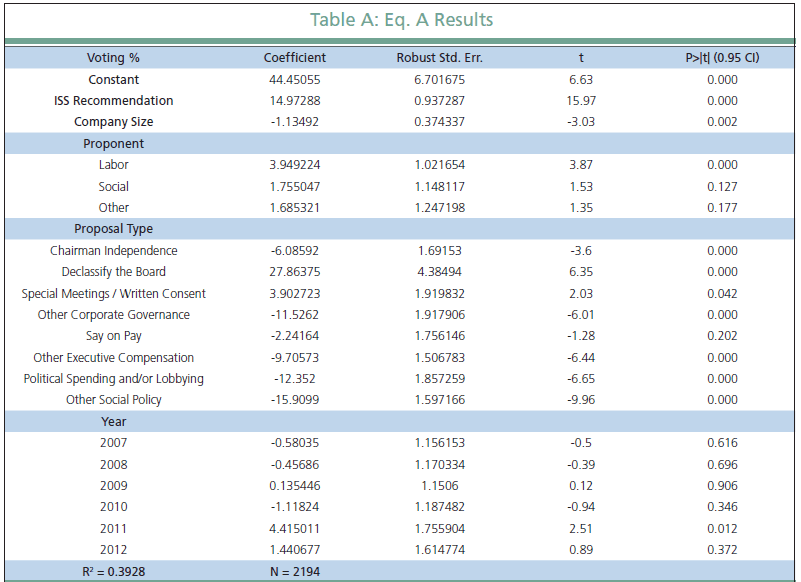
A statistical summary of the regression’s outcomes follows:
ISS Recommendation
The ISS recommendation is the most statistically significant explanatory variable in the model. A “for” recommendation by ISS, controlling for the other factors in the model, is associated with a 15-percentage-point increase in voting support for a given shareholder proposal. Such a finding is consistent with previous studies showing that ISS recommendations had a significant, sizable effect on shareholder voting.[68]
Company Size
Controlling for other factors, increases in company size are associated with reductions in voting support for shareholder proposals. Such an observation may be attributable to large companies’ larger, more sophisticated staffing handling corporate governance matters or to a more diversified shareholder base, complicating shareholder coordination. Larger companies may also be more likely to attract outlier proposals with more limited shareholder appeal, beyond what can be ascertained from the model’s broad categories of proposal types.
Proponent Types
The voting impact of Proponent Type is measured relative to individual proponents, a baseline variable for reasons explained in the technical appendix. Controlling for the other factors in the model, proposals sponsored by labor-affiliated pension funds are significantly more likely to attract shareholder support than those sponsored by individuals, though the impact of labor sponsorship—4 percentage points—is rather modest. The relatively high success of labor-backed proposals may be explained by relatively more sophisticated company- and issue-identification and proposal framing by pension-fund investors; or by coordinated or parallel voting responses among labor investors to labor-backed shareholder proposals.
SPECIAL FOCUS: THE ROLE OF INSTITUTIONAL SHAREHOLDER SERVICES (ISS)
In 1985, the proxy advisory firm ISS[69] was incorporated, with the intention of helping institutional investors deal with their responsibilities.[70] Prior to the 1980s, institutional investors had generally paid little attention to shareholder voting matters, but the wave of hostile takeover actions in that decade forced institutional investors to take at least occasional notice. Institutional investors’ broader need to assess shareholder voting issues, including proxy proposals, took on added significance in the late 1980s when the U.S. Department of Labor required retirement benefit funds governed by ERISA to vote their shares according to a “prudent man” standard,[71] and the SEC’s Division of Investment Management followed suit and determined that registered investment companies had to vote their shares to comply with their fiduciary duties to investors.[72] These requirements place significant burdens on institutional investors: according to a 2010 report by the Investment Company Institute, Russell 3000 companies faced more than 20,000 proxy ballot items annually—even before Dodd-Frank-required executive compensation voting.[73]
Institutional investors have substantially turned to ISS to assist them in meeting these voting obligations. Today a subsidiary of the investment company MSCI, ISS has a self-reported 1,700 clients,[74] managing an estimated $26 trillion in assets,[75] with a 61 percent market share in proxy advisory services.[76] Critics of ISS and the proxy advisory industry have questioned the market power over U.S. corporate governance being wielded by such a relatively small private entity, with just over 600 employees.[77] Before becoming a chancellor on the Delaware Court of Chancery, Leo Strine lamented that “[p]owerful CEOs come on bended knee to Rockville, Maryland, where ISS resides, to persuade the managers of ISS of the merits of their views about issues.”[78]
ISS vote recommendations on shareholder proposals introduced at Fortune 200 companies from 2006 through 2012 demonstrate that the proxy advisory firm is far more likely to support such proposals than the majority of shareholders. Shareholders and ISS tended to agree on the merits of proposals to declassify boards (which were supported by ISS 97 percent of the time and by a shareholder majority 84 percent of the time) and the lack of merit of shareholder proposals involving animal rights or a corporate statement on “health care reform principles” (which received no ISS recommendations and no shareholder majorities). For all other classes of proposals, however, ISS viewed management-opposed shareholder proposals far more favorably than did the majority of shareholders. While a majority of shareholders virtually never supported shareholder proposals involving equity compensation rules, political spending or lobbying, or chairman independence, ISS backed 75 percent, 70 percent, and 68 percent, respectively, of these proposal types. While only one shareholder proposal calling for the cumulative election of directors has received majority support, ISS has supported 96 percent of such proposals.[79] All told, ISS has supported over 63 percent of all shareholder proposals, while a majority of shareholders have supported less than 8 percent.
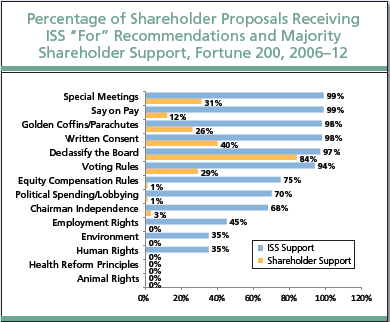 What might explain the dramatic, one-sided divergence between ISS’s recommendations and shareholders’ preferences? Although it is possible that ISS is better informed about shareholders’ interests in shareholder proposals than shareholders themselves and that shareholders are simply getting such questions wrong, such a hypothesis presumes that thousands of sophisticated institutional investors making large bets in their own interest are systematically erring relative to a single, small company with a limited budget and 600 employees. More plausibly, ISS’s recommendations are systematically biased in favor of shareholder-proposal activism. Because ISS’s business model depends on a large, diverse set of shareholder proposals, the company has an institutional incentive to support more such proposals. ISS receives consulting revenues from companies on how to structure executive compensation packages to meet with ISS’s approval,[80] which means that shareholder proposals that serve to increase corporate sensitivity to ISS’s preferences—such as say-on-pay proposals prior to the Dodd-Frank mandate, or proposals requiring directors to be elected annually or to receive a majority of shareholder votes—increase revenue opportunities for ISS.[81] Moreover, ISS receives significant revenues from social investment vehicles and labor-union pension funds, which gives the company an incentive to favor “socially responsible” investing proposals and labor-backed proposals.[82] What might explain the dramatic, one-sided divergence between ISS’s recommendations and shareholders’ preferences? Although it is possible that ISS is better informed about shareholders’ interests in shareholder proposals than shareholders themselves and that shareholders are simply getting such questions wrong, such a hypothesis presumes that thousands of sophisticated institutional investors making large bets in their own interest are systematically erring relative to a single, small company with a limited budget and 600 employees. More plausibly, ISS’s recommendations are systematically biased in favor of shareholder-proposal activism. Because ISS’s business model depends on a large, diverse set of shareholder proposals, the company has an institutional incentive to support more such proposals. ISS receives consulting revenues from companies on how to structure executive compensation packages to meet with ISS’s approval,[80] which means that shareholder proposals that serve to increase corporate sensitivity to ISS’s preferences—such as say-on-pay proposals prior to the Dodd-Frank mandate, or proposals requiring directors to be elected annually or to receive a majority of shareholder votes—increase revenue opportunities for ISS.[81] Moreover, ISS receives significant revenues from social investment vehicles and labor-union pension funds, which gives the company an incentive to favor “socially responsible” investing proposals and labor-backed proposals.[82]
Since ISS’s recommendations diverge from institutional shareholders’ preferences, why hasn’t a competitor emerged to challenge its position? The short answer is that the potential returns from providing a competitor service are not very large: notwithstanding its dominant market position, ISS’s operating income in 2011 from proxy advisory services was only $11.5 million, out of $119.6 million in revenues.[83] To meet their government-mandated fiduciary voting obligations, large institutional investors perform their own proxy analyses and seem to value ISS’s service largely for its data and analysis. Smaller institutional investors, who are more likely to “follow” ISS, place little value on shareholder voting rights themselves—they gain little value from voting “better,” as the broader voter-ignorance literature would suggest.[84] Thus, ISS today has only one competitor, Glass Lewis, which is itself owned by a teachers’ union pension fund.[85]
|
Proposal Types
The voting impact of Proponent Type is measured relative to the Voting Rules category, the omitted baseline proposal type (see technical appendix). Relative to shareholder proposals involving voting rules, those seeking to declassify the board of directors received an increase of almost 28 percentage points in shareholder voting support, holding other factors constant. Proposals seeking to permit shareholders to call special meetings or vote through written consent received increased shareholder support of 4 percentage points. Proposals seeking an independent board chairman received shareholder voting support 6 percentage points lower than baseline levels, and proposals involving political spending or lobbying received lower shareholder votes by over 12 percentage points.
Year
The only year exhibiting a statistically significant increase in voting support for shareholder proposals was 2011, when proposal support was 4.5 percentage points higher than the 2006 baseline. Notwithstanding this unexplained one-year increase in voting support for shareholder proposals in 2011, there appears to be no broad trend over time in voting support for shareholder proposals, nor was there a significant increase in voting support in the wake of the 2008 financial-market collapse. One hypothesis that could explain the atypically higher support for shareholder proposals in 2011 is that management diverted attention typically paid to such proposals that year toward management-sponsored say-on-pay proposals, mandated for all companies for the first time under Dodd-Frank.
Overall Model Interpretation
The model confirms the hypothesis that shareholder votes on shareholder proposals are significantly and sizably affected by the recommendation of the leading proxy advisory firm, ISS, and the type of proposal being introduced. The type of proponent, at least at a broad level of generality, is of limited usefulness in predicting shareholder support, though labor-backed proposals do receive modestly more support. There is no observable intertemporal trend in voting outcomes.
As measured by the R2 statistic, the model explains almost 40 percent of the variation in shareholder votes for shareholder proposals opposed by management. Omitted variables that are very likely to explain some of the remaining variance in shareholder votes include:
- Shareholder returns. We would expect investors to be more likely to defer to management when peer-indexed, risk-adjusted shareholder returns have been positive.
- Insider holdings. We would expect companies with large insider ownership—or multitiered classes of stock that give insiders more voting control—to have less voting support for management-opposed shareholder proposals.
- Institutional holdings. We would expect that the percentage of company stock held by institutional investors could influence shareholder voting support for shareholder proposals. Institutional holdings would likely have an interaction effect with ISS recommendations, which inform institutional investors’ votes.
- Executive compensation. At least for shareholder proposals related to executive compensation, executive pay level might be expected to have an impact on shareholder voting support.
In future follow-up research, we intend to control for some or all of these variables, to the extent that standardized data corresponding to our Proxy Monitor data set are available.
We initially hypothesized that a company’s industry might influence shareholder voting results, but industry specifications are not statistically significant and add little explanatory power to the model. Because these variables also introduce statistical problems, they were omitted from the final model, though results including industry variables are included in the technical appendix.
APPENDIX A: SAY ON PAY
The year 2012 was the second in which publicly traded American companies had to submit their executive compensation packages to shareholders for an advisory vote under Dodd-Frank.[86] To date in 2012, the average shareholder vote on proposed executive compensation packages among Fortune 200 companies is virtually identical to that in 2011, rising marginally from 87.5 percent to 87.8 percent. In 2012, a majority of shareholders at three Fortune 200 companies (Best Buy, Citigroup, and Community Health Systems) have rejected pay packages for management, just as shareholders rejected three packages among the Fortune 200 in 2011 (Constellation Energy, Freeport McMoRan, and Hewlett-Packard).
As was the case with shareholder proposals, ISS tended to be significantly more likely to oppose management’s proposed executive compensation packages than were shareholders. In 2011 and 2012, for the Fortune 200, ISS recommended “Against” votes in 13 percent of cases, but a majority of shareholders were opposed to the packages only 1.5 percent of the time. That said, ISS recommendations did seem to have a marked influence on the percentage of shareholders voting for a given company’s plan: shareholder votes averaged 91 percent at companies whose proposed executive compensation packages received a “For” recommendation from ISS, as opposed to only 64 percent among companies receiving an ISS “Against” vote.
To test ISS’s influence voting influence over say on pay more systematically, Manhattan Institute researchers specified an econometric model controlling for year and company size.
Voting % = β0 + Company Size + Year + ISS Recommendation + ε Eq. B
Under this basic model, the recommendation of ISS significantly affects shareholder votes on executive compensation, and a positive ISS recommendation leads to an increased shareholder “For” vote on proposed pay packages of 17.5 percent. Moreover, this basic estimation explains only about 9 percent of variation in say-on-pay votes. As with the shareholder-proposal model, omitted variables that could explain some of the remaining variation in say-on-pay votes include insider and institutional ownership, as well as stock-market returns and executive compensation levels. Because the last two variables are direct components of ISS’s executive compensation model,[87] at least some of the variance in say-on-pay votes attributed to ISS in our model may be explained by these omitted variables.

TECHNICAL APPENDIX
To shed more light on the differential impacts of proposal type, proponent type, industry, and year on voting outcomes for shareholder proposals than can be gleaned from summary statistics—as well as to assess the impact of company size and ISS recommendations on such votes—Manhattan Institute researchers constructed econometric models that could help explain shareholder-proposal voting results.[88]
Data
Our data set comes from the Manhattan Institute’s Proxy Monitor database at ProxyMonitor.org. The data set contains proposal-level data on the Fortune 200 companies over the six-year period from 2006 to 2012.
Methodology
We treated this data set as pooled cross-sectional data, including years as controls in our econometric specification. As such, we decided to use standard Ordinary Least Squares (OLS) regression to analyze the data. For categorical variables such as industry and proponent type, one group was excluded in the regression to avoid perfect multicollinearity. Effect sizes for categorical variables—proposal type, industry, proponent type, and year—should be understood in the context of being relative to the excluded group.[89]
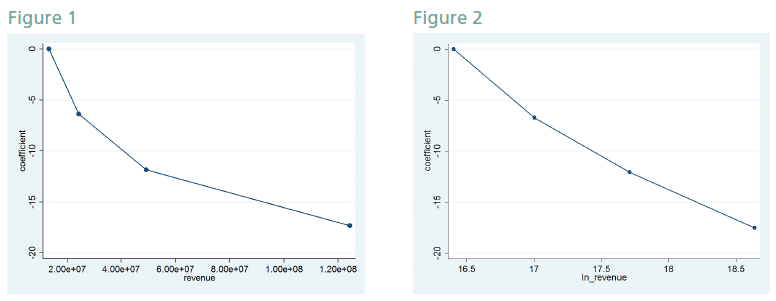
Logarithmic Specification: Company Size
Our expectation that the effects of company size on votes “For” a shareholder proposal might follow a nonlinear path was confirmed graphically, as shown in Figure 1.
Figure 1 was derived by breaking the continuous covariate (the raw value of revenue) into quartiles, and then reestimating the linear model using dummy variables for the quartiles. The graph shows estimated coefficients plotted against the midpoints of the quartiles.[90] This allows us to visually confirm the presence of a nonlinear relationship.
After taking the natural log of the revenue variable, however, we run the model through the same tests and obtain visual confirmation of a linear relationship, as shown in Figure 2.
Although the relationship has been linearized by transforming the revenue variable, the underlying relationship is still nonlinear in nature. As revenues increase, the effect on votes in favor of a proposal decreases at a decreasing rate.
Additional Model Specifications
In addition to the model specification described in the main body of the paper, we constructed additional models including: (1) management say-on-pay and say-on-frequency proposals—required of all companies in 2011 and 2012 under Dodd-Frank, and present in the Proxy Monitor database; and (2) industry categorical variables.
Our broadest econometric model was constructed as follows:
Voting % = β0 + Company Size + Industry + ProposalType +
ProponentType + Year + ISS Recommendation + ε Eq. C
Proponent type included management. Agribusiness was the excluded industry variable.
Eq. C suffers from multicollinearity, as the industry categories are collinear within the model as specified. Looking at both the Tolerance of Xk and the Variance Inflation Factor, we found significant multicollinearity for the industry variables.[92] We thus constructed an additional specification omitting the industry variable:
Voting % = β0 + Company Size + Proposal Type +
Proponent Type+ Year + ISS Recommendation + ε Eq. D
Removing the 11 industry variables, the R2 fell by only 0.001, and the robust standard error for the constant fell quite a bit, leading to a more precise estimate of the intercept, suggesting a more precise model.
The year variables for 2011 and 2012 in this specification each appear significant, but the significance of 2012 disappears once management say-on-pay proposals for those two years are omitted from the data set, as shown in the main body of the report. Because management sponsorship is limited to those two years—and perfectly correlated with the say-on-pay proposal type—we omitted these data from the final specification, which we determined necessary to capturing accurately shareholder-proposal activity, notwithstanding that the final specification resulted in a lower explanatory valuable for the regression as measured by R2.
Remaining Technical Concerns
1) Unobserved Heterogeneity / Omitted Variable Bias: As discussed in the main body of the report, omitted variables such as shareholder returns, insider holdings, institutional holdings, and executive compensation may help to explain variance in shareholder-proposal votes outside our model.
2) Multicollinearity: Apart from the discussed industry variables, our statistical tests indicate that multicollinearity is not a major issue. There may be reasons to believe, however, that ISS recommendations might vary systematically, on the basis of the sources or types of those proposals.
3) Heteroscedasticity: Breusch-Pagan and White tests confirmed our suspicions of heteroscedasticity.[93] Thus, in all our specifications, we corrected for heteroscedasticity by using heteroscedasticity-robust standard errors,[94] which in the presence of large samples are asymptotically valid with any unknown form of heteroscedasticity[95]
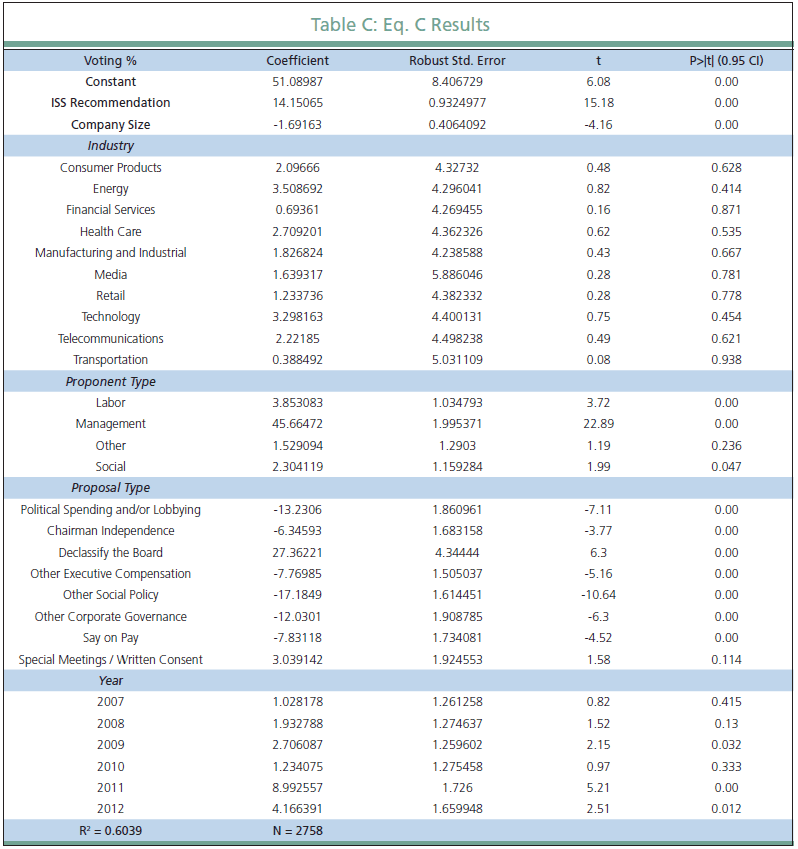
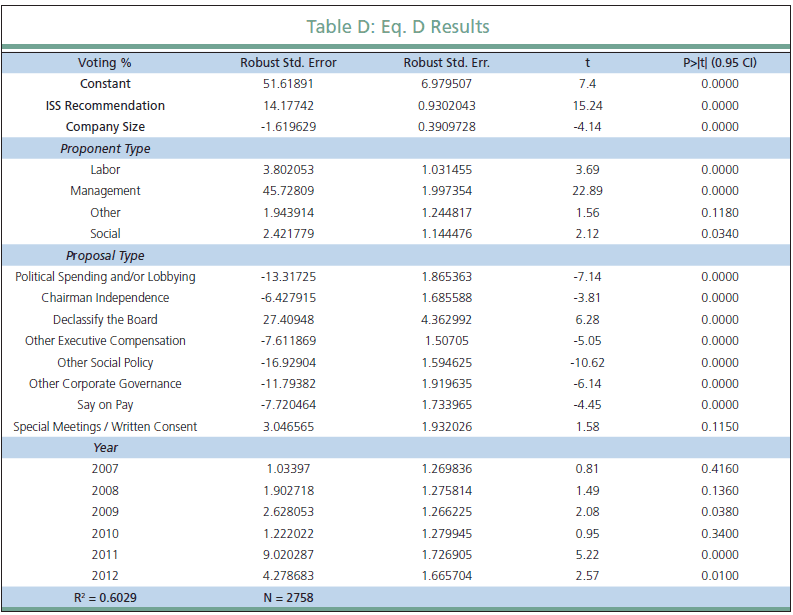
ENDNOTES
- See, e.g., Katherine R. Lewis & Ben Protess, Once-Reticent Investors Join Shareholder Revolts, N.Y. Times, June 7, 2012, http://dealbook.nytimes.com/2012/06/07/once-reticent-investors-join-shareholder-revolts/; Jessica Silver-Greenberg & Nelson D. Schwartz, Citigroup’s Chief Rebuffed on Pay by Shareholders, N.Y. Times, Apr. 17, 2012, http://dealbook.nytimes.com/2012/04/17/citigroup-shareholders-reject-executive-pay-plan; Scott Thurm & David Benoit, Activists Go After Big Game, Wall St. J., July 16, 2012, http://online.wsj.com/article/SB10001424052702303612804577529064175286508.html; Harold Meyerson, Unions Wield New Power as Shareholders, Wash. Post, June 5, 2012, http://www.washingtonpost.com/opinions/unions-wield-new-power-as-shareholders/2012/06/05/gJQAIigxGV_story.html.
- See, e.g., Greenberg & Schwartz, supra note 1; Suzanne McGee, Shareholder Spring? Protesters Roil Annual Meetings, Fiscal Times, May 10, 2012, http://money.msn.com/top-stocks/post.aspx?post=c63bfa9d-bc77-4479-8958-c2eccca6c849 (describing protests by “The 99 percent Movement,” an offshoot of the Occupy Wall Street movement, at annual meetings for companies including Bank of America, Citigroup, General Electric, and Wells Fargo). See also Patricia Sabatini, Protesters, Shareholders Vent Grievances at BNY Mellon Annual Meeting, Pittsburgh Post-Gazette, Apr. 11, 2012, http://www.post-gazette.com/stories/business/news/protesters-shareholders-vent-grievances-at-bny-mellon-annual-meeting-630794.
- See, e.g., Editorial, Shutting Up Business, Wall St. J., Dec. 29, 2011, http://online.wsj.com/article/SB10001424052970204224604577030260580411048.html; Editorial, Intimidation by Proxy, Wall St. J., May 8, 2012, http://online.wsj.com/article/SB10001424052702304746604577381882918797726.html; Editorial, Union Disclosure Rout, Wall St. J., May 16, 2012, http://online.wsj.com/article/SB10001424052702303360504577408331822623126.html?mod=WSJ_Opinion_AboveLEFTTop; Editorial, Where Have All the Proxies Gone?, Wall St. J., May 30, 2012, http://online.wsj.com/article/SB10001424052702303552104577436373145736912.html#articleTabs%3Darticle; see also John Milton Cooper, Letter to the Editor, Wall St. J., Jan. 6, 2012, http://online.wsj.com/article/SB10001424052970204632204577127250984881284.html.
- Pub. L. No. 111-203, 124 Stat. 1376, §951 (2010) [hereinafter Dodd-Frank Act].
- See 17 C.F.R. § 240.14a-8 (2007) [hereinafter 14a-8]. The SEC determines the procedural appropriateness of a shareholder proposal for inclusion on a corporation’s proxy ballot, pursuant to the Securities Exchange Act of 1934, Pub. L. No. 73-291, Ch. 404, 48 Stat. 881 (1934) (codified at 15 U.S.C. §§ 78a–78oo (2006 & Supp. II 2009)), at §§ 78m, 78n & 78u; 15 U.S.C. §§ 80a-1 to 80a-64 (2000) (pursuant to, Investment Company Act of 1940, Pub. L. No. 76-768, 54 Stat. 841(1940)); but the substantive rights governing such measures and how they can force boards to act remain largely a question of state corporate law, cf. Del. Code Ann., tit. 8, § 211(b) (2009) (noting that in addition to the election of directors, “any other proper business may be transacted at the annual meeting”).
- Substantial disagreement exists as to whether share value should be the principal metric used to evaluate the governance of shareholder corporations. Such is the traditional American rule, dating to Dodge v. Ford Motor Co., 170 N.W. 668. (Mich. 1919), when the Michigan Supreme Court ruled that Henry Ford had a fiduciary duty to manage Ford Motor Company for the benefit of shareholders rather than employees or the broader community. This principle has been the dominant academic view as well, at least in the law and economics literature, tracing to the classic exposition of Adolph Berle and Gardiner Means of the primacy of shareholders’ interests in governing corporate managers’ fiduciary duties. See generally Adolph A. Berle & Gardiner C. Means, The Modern Corporation and Private Property (1932); see also Adolf A. Berle, Jr., For Whom Corporate Managers Are Trustees: A Note, 45 Harv. L. Rev. 1365, 1367 (1932); Armen A. Alchian & Harold Demsetz, Production, Information Costs, and Economic Organization, 62 Am. Econ. Rev. 777 (1972); Michael C. Jensen & William H. Meckling, Theory of the Firm: Managerial Behavior, Agency Costs, and Ownership Structure, 3 J. Fin. Econ. 305 (1976).
However, the contrary view, that corporations owe a “social responsibility” beyond their fiduciary obligation to shareholders within legal norms, also has deep roots. This doctrine was classically advanced by Harvard professor Merrick Dodd. See E. Merrick Dodd, Jr., For Whom are Corporate Managers Trustees?, 45 Harv. L. Rev. 1145, 1148 (1932) (calling for “a view of the business corporation as an economic institution which has a social service as well as a profit-making function”); see also Christopher Stone, Where the Law Ends (1975); Ralph Nader, Mark Green & Joel Seligman, Taming the Giant Corporation (1976). But see David L. Engel, An Approach to Corporate Social Responsibility, 32 Stan. L. Rev. 1, 1 (1979) (critiquing the notion of corporate social responsibility).
In the late 1980s, many states enacted “stakeholder” or “constituency” statutes to enable corporate managers to consider factors other than shareholder return when considering hostile takeovers. See Mark G. Robilotti, Codetermination, Stakeholder Rights, and Hostile Takeovers: A Reevaluation of the Evidence from Abroad, 38 Harv. Int’l L.J. 536, 536-37 (1997). Scholars have debated the merits of these reforms. Compare Morey W. McDaniel, Stockholders and Stakeholders, 21 Stetson L. Rev.. 121, 151 (1991) (defending such legislation as consistent with early nineteenth-century norms) with Mark E. Van Der Weide, Against Fiduciary Duties to Corporate Stakeholders, 21 Del. Corp. L.J. 27, 86 (1996) (“Restricting the scope of managers’ fiduciary duties to shareholders alone will increase social wealth.”).
- Under the Employee Retirement Income Security Act of 1974 (ERISA), fiduciary duties governing employee benefit plan investment portfolios require that “in voting proxies. . . the responsible fiduciary shall consider only those factors that relate to the economic value of the plan’s investment and shall not subordinate the interests of the participants and beneficiaries in their retirement income to unrelated objectives,” 29 C.F.R. § 2509.08-2(1) (2008).
- See, e.g., Business Roundtable & Chamber of Commerce of the U.S. v. SEC, 647 F.3d 1144, 1152 (D.C. Cir. 2011), available at http://www.cadc.uscourts.gov/internet/opinions.nsf/89BE4D084BA5EBDA852578D5004FBBBE/$file/10-1305-1320103.pdf (citing proposition that “unions and state and local governments whose interests in jobs may well be greater than their interest in share value, can be expected to pursue self-interested objectives rather than the goal of maximizing shareholder value”) [hereinafter Business Roundtable v. SEC]; see also OIG Department of Labor Report, Proxy-Voting May Not Be Solely for the Economic Benefit of Retirement Plans, Rpt. No. 09-11-001-12-121, intro (March 31, 2011), http://www.oig.dol.gov/public/reports/oa/2011/09-11-001-12-121.pdf (questioning whether labor pension funds are using “plan assets to support or pursue proxy proposals for personal, social, legislative, regulatory, or public policy agendas”) [hereinafter OIG Department of Labor Report].
- See, e.g., Lucian A. Bebchuk, The Case for Increasing Shareholder Power, 118 Harv. L. Rev. 833 (2005).
- See, e.g., Stephen M. Bainbridge, Director Primacy: The Means and Ends of Corporate Governance, 97 Nw. U. L. Rev. 547 (2003).
- See James R. Copland, Proxy Monitor 2011: A Report on Corporate Governance and Shareholder Activism (Manhattan Inst. for Pol’y Res., Fall 2011), available at http://proxymonitor.org/Forms/pmr_02.aspx.
- See Copland, Reports and Findings: 2012 Season, ProxyMonitor.org., http://proxymonitor.org/Forms/reports_findings.aspx (last visited Sept. 1, 2012).
- See 14a-8, supra note 5.
- Barbarians at the Gate (Columbia Pictures Television 1993); Bryan Burrough & John Helyar, Barbarians at the Gate: The Fall of RJR Nabisco (1990).
- See, e.g., Robert Samuelson, Romney and ‘Private Equity’, Real Clear Politics, Jan. 13, 2012, http://www.realclearpolitics.com/articles/2012/01/13/romney_and_private_equity__112755.html.
- See, e.g., Roberta Romano, A Guide to Takeovers: Theory, Evidence, and Regulation, 9 Yale J. on Reg. 119, 120 (1992) (“The empirical evidence is most consistent with value-maximizing, efficiency-based explanations of takeovers.”).
- See Thurm & Benoit, supra note 1.
- See SEC Rel. No. 34-60215, available at http://www.sec.gov/rules/sro/nyse/2009/34-60215.pdf.
- Institutional Shareholder Services, http://www.issgovernance.com (last visited Aug. 8, 2011). A private organization that provides proxy voting and corporate governance services to institutional investors. The firm evaluates proxy proposals and makes voting recommendations to its clients.
- Dodd-Frank Act, supra note 4.
- “Corporate Gadflies” as commonly used in Charles M. Yablon, Overcompensating: The Corporate Lawyer and Executive Pay, 92 Colum. L. Rev. 1867, 1895 (1992); see also Jessica Holzer, Firms Try New Tack against Gadflies, Wall. St. J., Jun. 6, 2011,
http://online.wsj.com/article/SB10001424052702304906004576367133865305262.html.
- Renee McGaw, Shareholder activist known for holding CEOs’ feet to the fire, Denver Bus. J., May 20, 2010, http://www.bizjournals.com/denver/stories/2010/05/31/story4.html?page=all.
- Cf. John C. Harrington, Investing Your Conscience: How to Achieve High Returns Using Socially Responsible Investing (1992).
- See Securities and Exchange Commission, Spotlight: Evelyn Davis, Editor of Highlights and Lowlights, http://www.sec.gov/spotlight/proxyprocess/bio052507/eydavis.pdf (last visited Aug. 9, 2012).
- See Corporate top guns listen to ‘gadfly with a fortune’, Times Daily, Apr. 15, 1990, available at http://news.google.com/newspapers?nid=1842&dat=19900415&id=SVgeAAAAIBAJ&sjid=HcgEAAAAIBAJ&pg=1304,2527701 (last visited Aug. 8, 2012) [hereinafter Corporate top guns].
- See Amy Feldman, Fighting The Fat Cats For Decades, Evelyn Davis Has Grilled Biz Bigwigs In Outrageous Fashion, NY Daily News, May 24, 1998, http://articles.nydailynews.com/1998-05-24/news/18069588_1_evelyn-y-davis-annual-meeting-mortar-attack.
- Id.
- See Jim Mateja, A Shareholder Gets Married To Chrysler, But She Won’t Hold Her Peace, Chicago Trib., Sept. 5, 1994, http://articles.chicagotribune.com/1994-09-05/business/9409050059_1_annual-meeting-evelyn-y-davis-chrysler-chairman-robert-eaton.
- See Feldman, supra note 26.
- See Corporate top guns, supra note 25.
- Id.
- See Nathaniel Popper, Step by step, activist investors gaining clout, Salt Lake City Tribune, Sept. 4, 2010, http://www.sltrib.com/sltrib/money/50211543-79/chevedden-steiner-corporate-resolutions.html.csp.
- Id.
- Id.
- Id.
- See Corporations feel effects of shareholder activists, Toledo Blade, June 13, 2004, available at http://news.google.com/newspapers?nid=1350&dat=20040613&id=eWlPAAAAIBAJ&sjid=WQQEAAAAIBAJ&pg=6857,3603243 (last visited Aug. 9, 2012).
- Id.
- Id.
- Aaron Elstein, Harassed companies swat at gadflies, Crain’s New York Business, Feb. 8, 2009, http://www.crainsnewyork.com/article/20090208/SUB/302089967.
- See UPDATE: Susman Godfrey L.L.P Wins Fifth Circuit Appeal for KBR, Inc. Against Shareholder Activist, myfoxal.com, June 14, 2012, http://www.myfoxal.com/story/18788028/update-susman-godfrey-llp-wins-fifth-circuit-appeal-for-kbr-inc-against-shareholder-activist; Holzer, supra note 21.
- Tim Feran, Limited fighting investor complaint, Columbus Dispatch, Jan. 23, 2011, http://www.dispatch.com/content/stories/business/2011/01/23/limited-fighting-investor-complaint.html.
- The Nathan Cummings Foundation, http://www.nathancummings.org/about-the-foundation (last visited Aug. 9, 2012).
- Wyatt Andrews, Vatican reprimands U.S. nuns over ‘radical feminist themes’, CBS News (April 20, 2012), http://www.cbsnews.com/8301-18563_162-57418254/vatican-reprimands-u.s-nuns-over-radical-feminist-themes/.
- Pub. L. No. 111-148, 124 Stat 119 (2010) [hereinafter ACA].
- See James R. Copland, Season-End Report: Evidence suggests union-fund shareholder activism related to objectives other than share price (Manhattan Inst. for Pol’y Res., 2012), http://proxymonitor.org/Forms/2012Finding4.aspx; see also Copland, Shareholder Activism: What to Watch for in the 2012 Proxy Season, (Manhattan Inst. for Pol’y Res., Winter 2012), http://proxymonitor.org/Forms/pmr_03.aspx.
- See, e.g., James A. Brickley, Jeffrey L. Coles & Gregg Jarrell, Leadership Structure: Separating the CEO and Chairman of the Board, 3 J. Corp. Fin. 189 (1997) (finding no evidence that separating chairman and CEO roles improve financial performance); B. Ram Baliga, R. Charles Moyer & Ramesh S. Rao, CEO Duality and Firm Performance: What’s the Fuss?, 17 Strategic Mgmt. J. 41 (1996) (finding no evidence of stock improvements after companies separated chairman and CEO positions); Lex Donaldson & James H. Davis, Stewardship Theory or Agency Theory: CEO Governance and Shareholder Returns, 16 Austl. J. Mgmt. 49 (1991) (finding evidence of higher stock returns for companies with dual chairmen-CEOs than those with separate positions). But see Steven Balsam, John Puthenpurakal & Arun Upadhyay, The Determinants and Performance Impact of Outside Board Leadership, Working Paper Dec. 22, 2011, available at http://papers.ssrn.com/sol3/papers.cfm?abstract_id=1361255; Brian K. Boyd, CEO Duality and Firm Performance: A Contingency Model, 16 Strategic Mgmt. J. 301 (1995) (finding slight improvements in financial performance of entire set of companies studied but significant industry-to-industry variance).
- Copland, supra at notes 12 and 45.
- Under the Employee Retirement Income Security Act of 1974 (ERISA), fiduciary duties governing employee benefit plan investment portfolios require that “in voting proxies. . . the responsible fiduciary shall consider only those factors that relate to the economic value of the plan’s investment and shall not subordinate the interests of the participants and beneficiaries in their retirement income to unrelated objectives.” 29 C.F.R. § 2509.08-2(1) (2008).
- See Meyerson, supra note 1.
- See OIG Department of Labor Report, supra note 8; see also Business Roundtable v. SEC, supra note 8.
- See United States Department of Labor, Union Affiliation of Employed Wage and Salary Workers by Occupation and Industry (2010),
http://www.bls.gov/news.release/union2.t03.htm.
- See, e.g., Steven Greenhouse, Union Effort Turns Its Focus to Target, N.Y. Times, May 23, 2011, http://www.nytimes.com/2011/05/24/business/economy/24target.html?pagewanted=all; Mike Elk, Too Big Not to Organize: SEIU-International Coalition Try to Unionize the Banks, Huffington Post, July 29, 2010, http://www.huffingtonpost.com/mike-elk/too-big-not-to-organize_b_663940.html.
- Drew Griffin & Kathleen Johnston, Citing Bailout, Union Wants to Organize Bank Workers, CNN, Dec. 8, 2008, http://articles.cnn.com/2008-12-08/us/bank.workers.union_1_bank-workers-suntrust-bb-t?_s=PM:US; Jenny Brown, Unions Say “Strip the Scripts” in Rite Aid Disputes, Labor Notes, Apr. 4, 2011, http://labornotes.org/2011/04/unions-say-strip-scripts-rite-aid-disputes; Chris Garlock, D.C. Safeway Workers Protest Replacement Worker Hiring Sites, AFL-CIO Now, Mar. 20, 2012, http://www.aflcio.org/Blog/Organizing-Bargaining/D.C.-Safeway-Workers-Protest-Replacement-Worker-Hiring-Sites; Spencer Woodman, Labor Takes Aim at Walmart—Again, The Nation, Jan. 23, 2012, http://www.thenation.com/article/165437/labor-takes-aim-walmart-again.
- Open Secrets, Influence and Lobbying, PACs: Exxon Mobil Summary 2010, http://www.opensecrets.org/pacs/lookup2.php?strID=C00121368&cycle=2010, (last visited Sept. 1, 2011).
- Open Secrets, Influence and Lobbying, PACs: Anadarko Petroleum 2010, http://www.opensecrets.org/pacs/lookup2.php?strID=C00231951&cycle=2010, (last visited Sept. 1, 2011).
- See Rex Knepp, Interior Grants Approval to Anadarko’s 3600-well Utah Project, Examiner.com, May 9, 2012, http://www.examiner.com/article/interior-grants-approval-to-anadarko-s-3600-well-utah-project.
- See Mark Anthony, Controversy on Shale Gas Boom and Burst Explained, Seeking Alpha, May 8, 2012, http://seekingalpha.com/article/569451-controversy-on-shale-gas-boom-and-burst-explained.
- See Edward McClelland, Basic Union Busting, NBC Chicago, Oct. 13, 2011, http://www.nbcchicago.com/blogs/ward-room/Basic-Union-Busting-131252434.html.
- See Christine McLaughlin & Rufino Gaytán, Labor: When Employees are Eligible for Multiple FLSA Overtime Exemptions, InsideCounsel, June 4, 2012, http://www.insidecounsel.com/2012/06/04/labor-when-employees-are-eligible-for-multiple-fls; Supreme Court Says No Overtime for Pharma Sales Reps, HR.BLR.com, June 19, 2012, http://hr.blr.com/HR-news/Compensation/Sales-Employee-Exemption/Supreme-Court-Says-No-Overtime-for-Pharma-Sales-Re.
- See Alison Fitzgerald, Dean Foods Accused as Dairy Farmers Say They Are Getting Milked, PPJ Gazette, May 28, 2010, http://ppjg.me/2010/05/28/dean-foods-accused-as-dairy-farmers-say-they-are-getting-milked/.
- For these and other purposes, the Manhattan Institute counts shareholder support consistent with a company’s practice. Some companies measure shareholder support by dividing the number of votes For by the total number of shares voting For and Against, and other companies measure shareholder support by dividing the number of favorable votes by the number of shares present and entitled to vote —effectively counting abstentions as Against votes. Because such voting rules are publicly available and thus known to shareholders, the Manhattan Institute takes the position that voting support is best measured according to the rules that each company actually uses to assess such support. All else being equal, assuming that at least some abstentions do not incorporate assumed knowledge of voting rules, a voting rule premised on the percentage of all shareholders present and entitled to vote, rather than shareholders voting For or Against, would lead to smaller voting percentages than the inverse rule—which would make shareholder proposals less likely to pass but also make it harder for companies to garner support for executive compensation plans and other corporate business conducted under such a rule.
- See Editorials and Letter to the Editor, supra note 3.
- See Center for Political Accountability,
http://www.politicalaccountability.net/ (last visited July 9, 2012).
- The Center for Political Accountability generally claims higher vote totals for its shareholder proposals by inflating its figures. It counts not the percentage of shareholder support (among all shareholders present in person or by proxy and entitled to vote at a shareholder meeting), but rather the percentage of support among shareholders voting For or Against. Many companies use the former rather than the latter metric for gauging shareholder support, and their voting rules are clearly disclosed to shareholders in company bylaws and proxy solicitations. As discussed in note 61 above, the Manhattan Institute believes that assessing vote shares according to companies’ own bylaws is the more appropriate measure.
In addition to the analysis of Proxy Monitor data, Manhattan Institute scholars have examined vote totals across the broader Fortune 500 and observed a similar decrease in shareholder support, from 28.6 percent in 2011 to 25.2 percent in 2012 for CPA-type proposals. In a June newsletter, Strong 2012 Proxy Votes Build Momentum for Political Transparency, Center for Political Accountability Newsletter, June 2012, http://www.politicalaccountability.net/index.php?ht=a/GetDocumentAction/i/6785, CPA claimed that 12 of the 19 companies that introduced CPA’s preferred political-spending-disclosure proposal in both 2011 and 2012 witnessed increases in support year-over-year. The Manhattan Institute did observe vote-share increases in 12 CPA-style proposals year-over-year, though the Institute counts 22 repeat proposals, rather than 19. Across all these proposals, support fell from 29.5 percent in 2011 to 27.8 percent in 2012.
- John C. Coates, IV, Corporate Politics, Governance, and Value Before and After Citizens United (Working Paper 2012), available at
http://www.law.harvard.edu/news/2010/10/26_coates.html; Coates, Corporate Governance and Corporate Political Activity: What Effect Will Citizens United Have on Shareholder Wealth? (Harvard John M. Olin Ctr. for Law, Econ., & Bus., Discussion Paper No. 684, 2010), available at http://blogs.law.harvard.edu/corpgov/2010/09/30/what-effect-will-citizens-united-have-on-shareholder-wealth/; Rajesh K. Aggarwal, Felix Meschke & Tracy Yue Wang, Corporate Political Contributions: Investment or Agency?, 14 Business & Politics 1 (2012), available at http://papers.ssrn.com/sol3/papers.cfm?abstract_id=972670.
- See Robert J. Shapiro & Douglas Dowson, Corporate Political Spending: Why the New Critics Are Wrong, in Legal Pol’y Rep. 15, 17-22 (Manhattan Inst. for Pol’y Res. June 2012),
http://www.manhattan-institute.org/html/lpr_15.htm.
- A 2012 Media Matters strategy memorandum expressed an “end goal” for “corporate transparency” efforts of “mak[ing] the case that political spending is not within the fiduciary interest of publicly traded companies and therefore should be limited.” On file with author.
- See, e.g., Stephen Choi, Jill Fisch & Marcel Kahan, The Power of Proxy Advisors: Myth or Reality?, 59 Emory L.J. 886 (2010); James Cotter, Alan Palmiter & Randall Thomas, ISS Recommendations and Mutual Fund Voting on Proxy Proposals, 55 Villanova L. Rev. 3 (2010); Jie Cai, Jacqueline L. Garner & Ralph A. Walking, Electing Directors, 64 J. Fin. 2404 (October 2009); Jennifer Bethel & Stuart Gillan, The Impact of the Institutional and Regulatory Environment on Shareholder Voting, 31 Fin. Mgmt. 25 (Winter 2002).
- See Institutional Shareholder Services, available at http://www.issgovernance.com/about (last visited Aug. 9, 2012); Press Release, ISS, Institutional Shareholder Services Raises the Bar for Transparency and Responsiveness (Mar. 29, 2012), http://www.issgovernance.com/press/frb.
- See Robyn Bew & Richard Fields, Voting Decisions at US Mutual Funds: How Investors Really Use Proxy Advisers 6 (Tapestry Networks, Inc. & Investment Research Center Institute, June 2012), available at http://www.tapestrynetworks.com/issues/corporate-governance/upload/Voting-Decisions-at-US-Mutual-Funds-June-2012.pdf.
- See Letter from U.S. Dep’t of Labor to Helmuth Fandl, Chairman of Retirement Board, Avon Products, Inc. (Feb. 23, 1988); see also 73 Fed. Reg. 61731 (Oct. 17, 2008).
- Cf. 68 Fed. Reg. 6585 (Feb. 7, 2003) (“The duty of care requires an adviser with proxy voting authority to monitor corporate events and to vote the proxies. To satisfy its duty of loyalty, the adviser must cast the proxy votes in a manner consistent with the best interest of its client and must not subrogate client interests to its own” (internal citations omitted)). See generally Bew & Fields, supra note 70, at 5 (“In the late 1980s, the SEC and Department of Labor formally attached fiduciary obligations to voting on corporate governance matters. These actions demand that, instead of passive adherence to management’s recommendations, each institutional investor vote all of its portfolio shares on every matter brought to shareholders in accordance with the standards of the proverbial prudent man.” (internal quotation marks omitted)).
- Investment Company Institute, Trends in Proxy Voting by Registered Investment Companies, 2007–2009, 16 Research Perspective 4 (November 2010), available at http://www.ici.org/pdf/per16-01.pdf.
- See ISS, supra note 69.
- See European Securities and Markets Authority, An Overview of the Proxy Advisory Industry: Considerations on Possible Policy Options 11 (Paris: European Securities and Markets Authority, 2012), available at http://www.esma.europa.eu/system/files/2012-212.pdf.
- See Tamara Bellinfanti, The Proxy Advisory and Corporate Governance Industry: The Case for Increased Oversight and Control, 14 Stan. J.L. Bus. & Fin. 14 (Spring 2009).
- See, e.g., David F. Larcker, Allan L. McCall & Gaizka Ormazabal, Proxy Advisory Firms and Stock Option Exchanges: The Case of Institutional Shareholder Services 2 (Stanford GSB Research Paper No. 2077, Rock Center for Corporate Governance Working Paper no.100, April 24, 2011).
- Leo E. Strine, Jr., The Delaware Way: How We Do Corporate Law and Some of the New Challenges We (and Europe) Face, 30 Del. J. Corp. L. 688 (2005).
- Interestingly, ISS’s strong preference for chairman independence proposals and overwhelming preference for cumulative voting proposals is not reflected in the governing rules of the proxy advisory firm’s public parent company MSCI, which has a joint chairman and CEO, Henry A. Fernandez, and no cumulative voting rule (and a stated board policy “strongly support[ing] the one share/one vote concept and oppos[ing] cumulative voting,” MSCI Corporate Governance Policies, at
http://ir.msci.com/documentdisplay.cfm?DocumentID=2979).
- ISS parent company MSCI reports that over 21 percent of its annual Governance-segment revenues come from such corporate consulting arrangements. See MSCI 2011 Annual Report 9, 19, available at
http://files.shareholder.com/downloads/MSCI/2008427917x0x554571/96AD1F8D-CC19-4BFD-9E47-6EFD2079886C/264713_007_MSCI_BMK_AR.pdf.
- Cf. id. at 34 (“ISS’s historical growth has been due, in large part, to increased regulatory requirements, highly visible corporate scandals, increased shareholder activism and corporate chief executive officers and boards of directors that are increasingly concerned about, and responsive to, shareholder concerns.”).
- Cf. id. at 8 (describing ISS’s development of specialized services for its client base including socially responsible investment policies “based on environmentally and socially responsible guidelines” and a “Taft-Hartley benchmark policy which is based on guidelines of the American Federation of Labor and Congress of Industrial Organizations”).
- Id. at 65.
- See generally Bryan Caplan, The Myth of the Rational Voter (2007). Institutional investors compete aggressively for investor dollars, and they gain competitive advantages largely through higher returns and lower fees. Investing in proxy-voting information raises institutional investors’ costs while giving no competitive advantage in increasing investment returns, at least for smaller, diversified investors who have low ownership shares—and whose individual votes on proxy ballot items are therefore unlikely to be dispositive.
- See Bew & Fields, supra note 70, at 6.
- Not all companies submitted pay packages in 2012 because the shareholders of some companies opted to review executive compensation biennially or triennially rather than annually.
- See ISS 2012 Corporate Governance Policy Updates, MSOP 9-11, available at http://www.issgovernance.com/files/ISS_2012US_Updates20111117.pdf.
- Manhattan Institute research associate Yevgeniy Feyman led the econometric modeling project under the guidance and supervision of primary author and Center for Legal Policy director James Copland. Andrew Marcum, a research intern at the Manhattan Institute, assisted in building the econometric specification.
- For a deeper explanation of why excluded categories are necessary see Jeffrey M. Wooldridge, Introductory Econometrics: A Modern Approach 233-64 (2009).
- This was computed using the lincheck module for Stata, developed by Alex Gamma, University Hospital of Psychiatry, Research Department, Zurich, Switzerland.
- The Tolerance of Xk is 1–R2XkGk, where R2XkGk is the correlation of X with all other variables in the model. The Variance Inflation Factor is the reciprocal of the Tolerance, and tells us how much the variance of an estimator is being inflated by multicollinearity.
- The computation was performed using the collin module for Stata, developed by Philip B. Ender, UCLA Department of Education UCLA, Academic Technology Services.
- Heteroscedasticity, var(u|x)=h(xi)σ2, is a violation of the Gauss-Markov assumption of constant variance in residuals, or homoscedasticity (var(u|x)=h(xi)σ2).
- We use White’s robust standard errors using Stata’s (vce)robust command.
- For a fairly detailed discussion and justification for using robust standard errors, see Wooldridge, supra note 89, at 276-309.
ACKNOWLEDGMENTS
This report’s primary author, James R. Copland, wishes to acknowledge the contributions made by listed co-authors Yevgeniy Feyman and Margaret M. O’Keefe, without whom this report would have been impossible. Mr. Feyman led the econometric modeling project under Mr. Copland’s guidance and supervision. Ms. O’Keefe oversaw the Proxy Monitor database as a whole, checked data for errors, and offered insights on Institutional Shareholder Services, Dodd-Frank and other operative laws and regulations, and other subjects covered in this report.
Manhattan Institute vice president for policy Howard Husock and Center for Legal Policy project manager Isaac Gorodetski also gave valuable substantive input into this report. Manhattan Institute interns Jonathan Begner, Corina Cappabianca, Jarrett Dieterle, and Andrew Marcum each made significant research contributions. The Manhattan Institute’s editorial and production team, under the guidance of managing editor Matthew Hennessey, was also essential to this effort.
ABOUT THE AUTHORS
JAMES R. COPLAND is the director of and a senior fellow with the Manhattan Institute’s Center for Legal Policy, which seeks to develop and communicate thoughtful ideas on how to improve the civil and criminal justice system. Copland oversees the Institute’s new corporate governance website, ProxyMonitor.org. In 2011, the National Association of Corporate Directors named Mr. Copland one of the 100 individuals most influential over corporate governance in the United States.
Prior to joining the Manhattan Institute, Copland was a management consultant with McKinsey and Company in New York. He had earlier served as a law clerk for Ralph K. Winter on the United States Court of Appeals for the Second Circuit. Copland received J.D. and M.B.A degrees from Yale, where he was an Olin Fellow in Law and Economics and an editor of the Yale Journal on Regulation. He also has an M.Sc. in politics of the world economy from the London School of Economics and a B.A. in economics with highest distinction and highest honors from the University of North Carolina at Chapel Hill, where he was a Morehead Scholar.
YEVGENIY FEYMAN is a research associate with the Manhattan Institute, focusing on a wide range of policy analysis covering healthcare, energy, education, and social policy. He received his B.A. in economics and political science from Hunter College.
MARGARET M. O’KEEFE is the project manager for the Manhattan Institute’s Proxy Monitor. She has extensive experience with corporate governance and executive compensation consulting and significant expertise in regulatory policy affecting capital markets, focusing on SEC corporate disclosure issues and the regulatory compliance framework. She is a graduate of St. John’s University School of Law and received an LL.M. in financial services law from New York Law School.